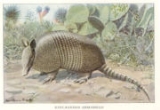
List of mammals of Argentina
Encyclopedia
This is a list of the mammal species recorded in Argentina. As of February 2011, the list contains 398 mammal species from Argentina
, of which 1 is extinct, 6 are critically endangered, 14 are endangered, 19 are vulnerable, and 31 are near-threatened.
The following tags are used to highlight each species' conservation status as assessed by the IUCN
:
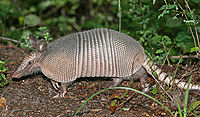

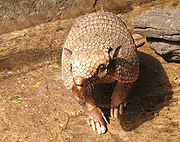 The armadillos are small mammals with a bony armored shell. They are native to the Americas. There are around 20 extant species.
The armadillos are small mammals with a bony armored shell. They are native to the Americas. There are around 20 extant species.
Order: Pilosa
----
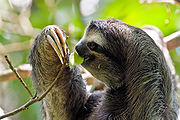
 The order Pilosa is extant only in the Americas and includes the anteater
The order Pilosa is extant only in the Americas and includes the anteater
s, sloth
s, and tamandua
s.
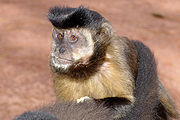
 The order Primates contains all the species commonly related to the lemur
The order Primates contains all the species commonly related to the lemur
s, monkey
s, and ape
s, with the latter category including humans. It is divided informally into three main groupings: prosimian
s, monkeys of the New World
, and monkeys and apes of the Old World
.
Order: Rodent
----
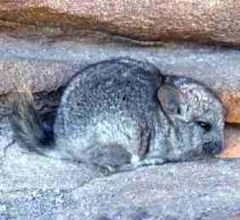
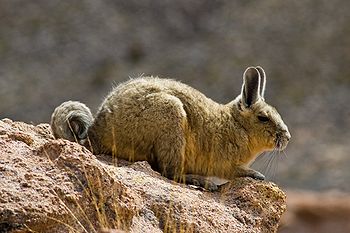



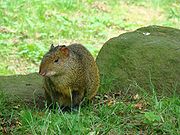
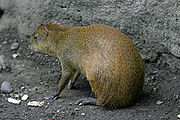
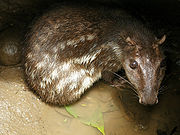
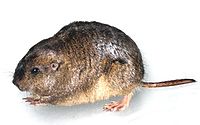
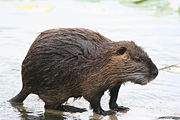 Rodents make up the largest order of mammals, with over 40 percent of mammalian species. They have two incisor
Rodents make up the largest order of mammals, with over 40 percent of mammalian species. They have two incisor
s in the upper and lower jaw which grow continually and must be kept short by gnawing. Most rodents are small though the capybara
can weigh up to 45 kg (100 lb).

Order: Lagomorpha
----
The lagomorphs comprise two families, Leporidae
(hare
s and rabbit
s), and Ochotonidae (pika
s). Though they can resemble rodent
s, and were classified as a superfamily
in that order until the early 20th century, they have since been considered a separate order. They differ from rodents in a number of physical characteristics, such as having four incisors in the upper jaw rather than two.
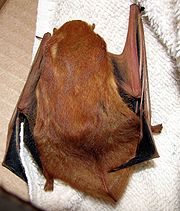
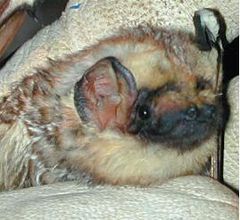
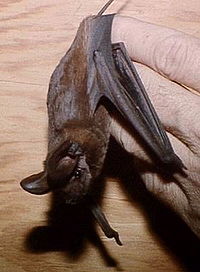

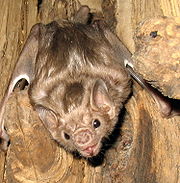 The bats' most distinguishing feature is that their forelimbs are developed as wings, making them the only mammals in the world naturally capable of flight. Bat species account for about 20% of all mammals.
The bats' most distinguishing feature is that their forelimbs are developed as wings, making them the only mammals in the world naturally capable of flight. Bat species account for about 20% of all mammals.
Order: Carnivora
----


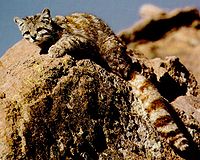

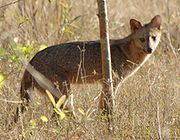

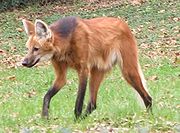
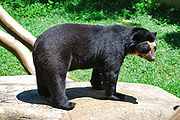 There are over 260 species of carnivorans, the majority of which feed primarily on meat. They have a characteristic skull shape and dentition.
There are over 260 species of carnivorans, the majority of which feed primarily on meat. They have a characteristic skull shape and dentition.
The odd-toed ungulates are browsing and grazing
mammals. They are usually large to very large, and have relatively simple stomachs and a large middle toe.



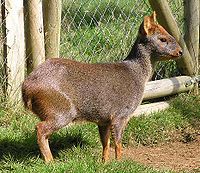 The even-toed ungulates are ungulate
The even-toed ungulates are ungulate
s whose weight is borne about equally by the third and fourth toes, rather than mostly or entirely by the third as in perissodactyls. There are about 220 artiodactyl species, including many that are of great economic importance to human
s.
Order: Cetacea
----

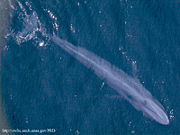







 The order Cetacea includes whale
The order Cetacea includes whale
s, dolphin
s and porpoise
s. They are the mammals most fully adapted to aquatic
life with a spindle-shaped nearly hairless body, protected by a thick layer of blubber, and forelimbs and tail modified to provide propulsion underwater.
Order: Didelphimorphia
----
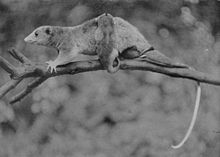
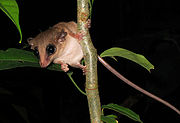
Didelphimorphia is the order of common opossums of the Western Hemisphere
. Opossums probably diverged from the basic South America
n marsupial
s in the late Cretaceous
or early Paleocene
.They are small to medium-sized marsupials, about the size of a large house cat
, with a long snout and prehensile tail.
There are six extant species of shrew opossum. They are small shrew
-like marsupial
s confined to the Andes
.
Order: Microbiotheria
----
 The Monito del Monte is the only extant member of its family and the only surviving member of an ancient order, the Microbiotheria.
The Monito del Monte is the only extant member of its family and the only surviving member of an ancient order, the Microbiotheria.
Argentina
Argentina , officially the Argentine Republic , is the second largest country in South America by land area, after Brazil. It is constituted as a federation of 23 provinces and an autonomous city, Buenos Aires...
, of which 1 is extinct, 6 are critically endangered, 14 are endangered, 19 are vulnerable, and 31 are near-threatened.
The following tags are used to highlight each species' conservation status as assessed by the IUCN
World Conservation Union
The International Union for Conservation of Nature and Natural Resources is an international organization dedicated to finding "pragmatic solutions to our most pressing environment and development challenges." The organization publishes the IUCN Red List, compiling information from a network of...
:
| EX | Extinct Extinction In biology and ecology, extinction is the end of an organism or of a group of organisms , normally a species. The moment of extinction is generally considered to be the death of the last individual of the species, although the capacity to breed and recover may have been lost before this point... |
No reasonable doubt that the last individual has died. |
| EW | Extinct in the Wild Extinct in the Wild Extinct in the Wild is a conservation status assigned to species or lower taxa, the only known living members of which are being kept in captivity or as a naturalized population outside its historic range.-Examples:... |
Known only to survive in captivity or as a naturalized population well outside its historic range. |
| CR | Critically Endangered Critically Endangered Critically Endangered is the highest risk category assigned by the IUCN Red List for wild species. Critically Endangered means that a species' numbers have decreased, or will decrease, by 80% within three generations.... |
The species is facing an extremely high risk of extinction in the wild. |
| EN | Endangered Endangered species An endangered species is a population of organisms which is at risk of becoming extinct because it is either few in numbers, or threatened by changing environmental or predation parameters... |
The species is facing a very high risk of extinction in the wild. |
| VU | Vulnerable Vulnerable species On 30 January 2010, the IUCN Red List of Threatened Species identified 9694 Vulnerable species, subspecies and varieties, stocks and sub-populations.-References:... |
The species is facing a high risk of extinction in the wild. |
| NT | Near Threatened Near Threatened Near Threatened is a conservation status assigned to species or lower taxa that may be considered threatened with extinction in the near future, although it does not currently qualify for the threatened status... |
The species does not currently qualify as being at high risk of extinction but it is likely to do so in the future. |
| LC | Least Concern Least Concern Least Concern is an IUCN category assigned to extant taxon or lower taxa which have been evaluated but do not qualify for any other category. As such they do not qualify as threatened, Near Threatened, or Conservation Dependent... |
The species is not currently at risk of extinction in the wild. |
| DD | Data Deficient Data Deficient Data Deficient is a category applied by the IUCN, other agencies, and individuals to a species when the available information is not sufficient for a proper assessment of conservation status to be made... |
There is inadequate information to assess the risk of extinction for this species. |
Order: Cingulata (armadillos)
----


- Family: Dasypodidae (armadillos)
- Subfamily: Dasypodinae
- Genus: DasypusDasypusDasypus is a genus of armadillo in the Dasypodidae family. It is the only genus in the subfamily Dasypodinae and contains the following species:*Nine-banded Armadillo, Dasypus novemcinctus*Seven-banded Armadillo, Dasypus septemcinctus...
- Southern Long-nosed ArmadilloSouthern Long-nosed ArmadilloThe Southern Long-nosed Armadillo, Dasypus hybridus, is an armadillo species from South America. It is found in Argentina, Brazil, Paraguay and Uruguay.-References:*...
Dasypus hybridus NT - Nine-banded ArmadilloNine-banded ArmadilloThe nine-banded armadillo , or the nine-banded, long-nosed armadillo, is a species of armadillo found in North, Central, and South America, making it the most widespread of the armadillos...
Dasypus novemcinctus LC**** Seven-banded ArmadilloSeven-banded ArmadilloSeven-banded, long-nosed armadillo or just seven-banded armadillo, Dasypus septemcinctus, is a species of armadillo from South America...
Dasypus septemcinctus LC - Yepes's MulitaYepes's MulitaYepes's mulita is a species of armadillo in the family Dasypodidae. It is endemic to Argentina. Its natural habitat is subtropical dry forests....
Dasypus yepesi DD
- Southern Long-nosed Armadillo
- Genus: Dasypus
- Subfamily: EuphractinaeEuphractinaeEuphractinae is a subfamily of armadillo in the Dasypodidae family. It contains the following genera:*Calyptophractus*Chaetophractus Hairy Armadillos*Chlamyphorus*Euphractus six-banded armadillos*Zaedyus pichis...
- Genus: ChaetophractusChaetophractusChaetophractus is a small genus of armadillos in the Dasypodidae family. It contains the following three species:*Screaming Hairy Armadillo, Chaetophractus vellerosus*Big Hairy Armadillo, Chaetophractus villosus...
- Andean Hairy ArmadilloAndean Hairy ArmadilloThe Andean Hairy Armadillo is an armadillo present in Bolivia, in the region of the Puna, the departments of Oruro, La Paz, and Cochabamba . Nowark describes it as distributed in Bolivia and northern Chile. A recent publication of Pacheco et al. also locates the species in Peru...
Chaetophractus nationi VU - Screaming Hairy ArmadilloScreaming Hairy ArmadilloThe Screaming Hairy Armadillo is a species of armadillo also known as the Small Screaming Armadillo, Crying Armadillo or the Small Hairy Armadillo. It is a burrowing armadillo found in the central and southern parts of South America...
Chaetophractus vellerosus LC - Big Hairy ArmadilloBig Hairy ArmadilloChaetophractus villosus, commonly called the Big Hairy Armadillo is one of the largest and most numerous armadillos in South America. It lives from sea level to altitudes of up to 1,300 meters across the southern portion of South America and can be found in grasslands, forests, savannahs, and has...
Chaetophractus villosus LC
- Andean Hairy Armadillo
- Genus: Calyptophractus
- Greater Fairy ArmadilloGreater Fairy ArmadilloThe greater fairy armadillo , also known as Burmeister's armadillo or the Chacoan fairy armadillo, is a species of armadillo in the family Dasypodidae. It is found in Argentina, Bolivia, and Paraguay. Its natural habitats are subtropical or tropical dry shrubland and subtropical or tropical dry...
Calyptophractus retusus DD
- Greater Fairy Armadillo
- Genus: Chlamyphorus
- Pink Fairy ArmadilloPink Fairy ArmadilloThe pink fairy armadillo or pichiciego is the smallest species of armadillo...
Chlamyphorus truncatus DD
- Pink Fairy Armadillo
- Genus: Euphractus
- Six-banded ArmadilloSix-banded ArmadilloThe Six-banded Armadillo , also known as the Yellow Armadillo, is a species of armadillo from South America. It is found in Argentina, Bolivia, Brazil, Uruguay, Paraguay and isolated populations in Suriname . Its body is usually yellowish in color, sometimes tan or light reddish-brown...
Euphractus sexcinctus LC
- Six-banded Armadillo
- Genus: Zaedyus
- PichiPichiThe Pichi or Dwarf Armadillo is a small armadillo that is the only member the genus Zaedyus. The range of the Pichi is from central and southern Argentina , west to the Andean grasslands of Chile and south to the Strait of Magellan.Its body is approximately long with a tail of 4-6 inches...
Zaedyus pichiy NT
- Pichi
- Genus: Chaetophractus
- Subfamily: TolypeutinaeTolypeutinaeTolypeutinae is a subfamily of armadillo in the Dasypodidae family. It contains the following three extant genera:Kuntinaru*Cabassous*Priodontes*Tolypeutes...
- Genus: CabassousCabassousCabassous is a genus of armadillo in the Dasypodidae family. It contains the following species:*Northern Naked-tailed Armadillo, Cabassous centralis*Chacoan Naked-tailed Armadillo, Cabassous chacoensis...
- Chacoan Naked-tailed ArmadilloChacoan Naked-tailed ArmadilloThe Chacoan Naked-tailed Armadillo is a species of armadillo in the Dasypodidae family. It is found in Argentina, Paraguay, and possibly Brazil. Its natural habitats are subtropical or tropical dry forests and subtropical or tropical dry shrubland. It is threatened by habitat loss....
Cabassous chacoensis NT - Greater Naked-tailed ArmadilloGreater Naked-tailed ArmadilloThe Greater Naked-tailed Armadillo, Cabassous tatouay, is an armadillo species from South America. It is found in Argentina, Bolivia, Brazil, Paraguay, Peru and Uruguay.-References:*...
Cabassous tatouay LC
- Chacoan Naked-tailed Armadillo
- Genus: Priodontes
- Giant ArmadilloGiant ArmadilloThe giant armadillo , colloquially tatou, ocarro, tatu-canastra or tatú carreta, is the largest living species of armadillo...
Priodontes maximus VU
- Giant Armadillo
- Genus: TolypeutesTolypeutesThe genus Tolypeutes contains the two species of three-banded armadillos. They are restricted to South America, mostly Brazil.- Species :There are two recognized species:* Tolypeutes matacus – Southern Three-banded Armadillo...
- Southern Three-banded ArmadilloSouthern Three-banded ArmadilloThe Southern Three-banded Armadillo , also called the La Plata Three-Banded Armadillo, is an armadillo species from South America...
Tolypeutes matacus NT
- Southern Three-banded Armadillo
- Genus: Cabassous
- Subfamily: Dasypodinae
Order: PilosaPilosaThe order Pilosa is a group of placental mammals, extant today only in the Americas. It includes the anteaters and sloths, including the recently extinct ground sloths....
(anteaters, sloths and tamanduas)
----

Anteater
Anteaters, also known as antbear, are the four mammal species of the suborder Vermilingua commonly known for eating ants and termites. Together with the sloths, they compose the order Pilosa...
s, sloth
Sloth
Sloths are the six species of medium-sized mammals belonging to the families Megalonychidae and Bradypodidae , part of the order Pilosa and therefore related to armadillos and anteaters, which sport a similar set of specialized claws.They are arboreal residents of the jungles of Central and South...
s, and tamandua
Tamandua
Tamandua is a genus of anteaters. It has two members: the Southern Tamandua and the Northern Tamandua . They live in forests and grasslands, are semi-arboreal, and possess partially prehensile tails. They mainly eat ants and termites, but they occasionally eat bees, beetles, and insect larvae...
s.
- Suborder: Folivora
- Family: Bradypodidae (three-toed sloths)
- Genus: Bradypus
- Brown-throated Three-toed SlothBrown-throated Three-toed SlothThe brown-throated sloth is a species of three-toed sloth. It is the most common of the four species of three-toed sloth, and is found in the forests of South and Central America.-Description:...
Bradypus variegatus LC
- Brown-throated Three-toed Sloth
- Genus: Bradypus
- Family: Bradypodidae (three-toed sloths)
- Suborder: Vermilingua
- Family: MyrmecophagidaeMyrmecophagidaeMyrmecophagidae is a family of anteaters, the name being derived from the Ancient Greek words for 'ant' and 'eat' . Myrmecophagids are native to Central and South America, from southern Mexico to northern Argentina. There are 2 genera and 3 species in the family, consisting of the Giant Anteater,...
(American anteaters)- Genus: Myrmecophaga
- Giant AnteaterGiant AnteaterThe Giant Anteater, Myrmecophaga tridactyla, is the largest species of anteater. It is the only species in the genus Myrmecophaga. It is found in Central and South America from Honduras to northern Argentina...
Myrmecophaga tridactyla VU
- Giant Anteater
- Genus: TamanduaTamanduaTamandua is a genus of anteaters. It has two members: the Southern Tamandua and the Northern Tamandua . They live in forests and grasslands, are semi-arboreal, and possess partially prehensile tails. They mainly eat ants and termites, but they occasionally eat bees, beetles, and insect larvae...
- Southern TamanduaSouthern TamanduaThe southern tamandua, also called a collared anteater, or lesser anteater , is a species of anteater from South America. It is a solitary animal, found in many habitats from mature to highly disturbed secondary forests and arid savannas. It feeds on ants, termites and bees...
Tamandua tetradactyla LC
- Southern Tamandua
- Genus: Myrmecophaga
- Family: Myrmecophagidae
Order: Primates
----

Lemur
Lemurs are a clade of strepsirrhine primates endemic to the island of Madagascar. They are named after the lemures of Roman mythology due to the ghostly vocalizations, reflective eyes, and the nocturnal habits of some species...
s, monkey
Monkey
A monkey is a primate, either an Old World monkey or a New World monkey. There are about 260 known living species of monkey. Many are arboreal, although there are species that live primarily on the ground, such as baboons. Monkeys are generally considered to be intelligent. Unlike apes, monkeys...
s, and ape
Ape
Apes are Old World anthropoid mammals, more specifically a clade of tailless catarrhine primates, belonging to the biological superfamily Hominoidea. The apes are native to Africa and South-east Asia, although in relatively recent times humans have spread all over the world...
s, with the latter category including humans. It is divided informally into three main groupings: prosimian
Prosimian
Prosimians are a grouping of mammals defined as being primates, but not monkeys or apes. They include, among others, lemurs, bushbabies, and tarsiers. They are considered to have characteristics that are more primitive than those of monkeys and apes. Prosimians are the only primates native to...
s, monkeys of the New World
New World monkey
New World monkeys are the five families of primates that are found in Central and South America: Callitrichidae, Cebidae, Aotidae, Pitheciidae, and Atelidae. The five families are ranked together as the Platyrrhini parvorder and the Ceboidea superfamily, which are essentially synonymous since...
, and monkeys and apes of the Old World
Catarrhini
Catarrhini is one of the two subdivisions of the higher primates . It contains the Old World monkeys and the apes, which in turn are further divided into the lesser apes or gibbons and the great apes, consisting of the orangutans, gorillas, chimpanzees, bonobos, and humans...
.
- Suborder: HaplorrhiniHaplorrhiniThe haplorhines, the "dry-nosed" primates , are members of the Haplorhini clade: the prosimian tarsiers and the anthropoids...
- Infraorder: Simiiformes
- Parvorder: Platyrrhini
- Family: CebidaeCebidaeThe Cebidae is one of the five families of New World monkeys now recognised. It includes the capuchin monkeys and squirrel monkeys. These species are found throughout tropical and subtropical South and Central America.-Characteristics:...
- Subfamily: Cebinae
- Genus: CebusCEBusCEBus, short for Consumer Electronics Bus, also known as EIA-600, is a set of electrical standards and communication protocols for electronic devices to transmit commands and data...
- Black-striped CapuchinBlack-striped CapuchinThe black-striped capuchin, Cebus libidinosus, also known as the bearded capuchin, is a capuchin monkey from South America. It was the first non-ape primate where tool usage was documented in the wild, as individuals have been seen cracking nuts by placing them on a stone "anvil" while hitting them...
Cebus libidinosus LC - Black CapuchinBlack CapuchinThe black capuchin, Cebus nigritus, also known as the black-horned capuchin, is a capuchin monkey from the Atlantic Forest in south-eastern Brazil and far north-eastern Argentina. Historically, it was included as a subspecies of the Tufted Capuchin....
Cebus nigritus NT
- Black-striped Capuchin
- Genus: Cebus
- Subfamily: Cebinae
- Family: Aotidae
- Genus: Aotus
- Azara's Night MonkeyAzara's Night MonkeyAzara's night monkey, Aotus azarae, is a night monkey species from South America. It is found in Argentina, Bolivia, Peru and Paraguay. It is named after Spanish naturalist Félix de Azara.There are three subspecies of this monkey:...
Aotus azarae LC
- Azara's Night Monkey
- Genus: Aotus
- Family: AtelidaeAtelidaeAtelidae is one of the five families of New World monkeys now recognised. It was formerly included in the family Cebidae. Atelids are generally larger monkeys; the family includes the howler, spider, woolly and woolly spider monkeys...
- Subfamily: Alouattinae
- Genus: Alouatta
- Black HowlerBlack HowlerThe Black howler is a species of howler monkey, a large New World monkey, from northeast Argentina, east Bolivia, east and south Brazil and Paraguay. Together with the brown howler, it is the southernmost member of the Alouatta genus. Only the adult male is black; adult females and juveniles of...
Alouatta caraya LC - Brown HowlerBrown HowlerThe Brown howler , also known as Brown howling monkey, is a species of howler monkey, a type of New World monkey, that lives in forests in south-eastern Brazil and far north-eastern Argentina . It lives in groups of 2 to 11 individuals...
Alouatta guariba LC
- Black Howler
- Genus: Alouatta
- Subfamily: Alouattinae
- Family: Cebidae
- Parvorder: Platyrrhini
- Infraorder: Simiiformes
Order: RodentRodentRodentia is an order of mammals also known as rodents, characterised by two continuously growing incisors in the upper and lower jaws which must be kept short by gnawing....
ia (rodents)
----









Incisor
Incisors are the first kind of tooth in heterodont mammals. They are located in the premaxilla above and mandible below.-Function:...
s in the upper and lower jaw which grow continually and must be kept short by gnawing. Most rodents are small though the capybara
Capybara
The capybara , also known as capivara in Portuguese, and capibara, chigüire in Venezuela, Colombia, and Ecuador ronsoco in Peru, chigüiro, and carpincho in Spanish, is the largest living rodent in the world. Its closest relatives are agouti, chinchillas, coyphillas, and guinea pigs...
can weigh up to 45 kg (100 lb).
- Suborder: HystricomorphaHystricomorphaThe term Hystricomorpha has had many definitions throughout its history. In the broadest sense it refers to any rodent with a hystricomorphous zygomasseteric system. This includes the Hystricognathi, Ctenodactylidae, Anomaluridae, and Pedetidae...
- Family: Erethizontidae (New World porcupines)
- Subfamily: Erethizontinae
- Genus: Coendou
- Brazilian PorcupineBrazilian PorcupineThe Brazilian Porcupine is a porcupine found in Brazil, Argentina, Venezuela, the Guyanas, Bolivia and Trinidad, with a single record from Ecuador. It inhabits tropical forests at elevations up to 1500 m....
Coendou prehensilis LC
- Brazilian Porcupine
- Genus: SphiggurusSphiggurusSphiggurus is a genus of New World porcupine. It contains the following species:*Sphiggurus ichillus - Streaked Dwarf Porcupine*Sphiggurus insidiosus - Bahia Porcupine*Sphiggurus melanurus - Black-tailed Hairy Dwarf Porcupine...
- Paraguaian Hairy Dwarf Porcupine Sphiggurus spinosus LC
- Genus: Coendou
- Subfamily: Erethizontinae
- Family: ChinchillidaeChinchillidaeThe family Chinchillidae contains the chinchillas, viscachas, and their fossil relatives. They are restricted to southern and western South America, often in association with the Andes. They are large rodents, weighing from to , with strong hind legs and large ears...
(viscachas and chinchillas)- Genus: ChinchillaChinchillaChinchillas are crepuscular rodents, slightly larger and more robust than ground squirrels, and are native to the Andes mountains in South America. Along with their relatives, viscachas, they make up the family Chinchillidae....
- Short-tailed ChinchillaShort-tailed ChinchillaThe short-tailed chinchilla , also called the Bolivian, Peruvian, and Royal chinchilla, is an endangered species of rodent. Their original range included the Andes Mountains of Argentina, Chile, Peru, and Bolivia...
Chinchilla chinchilla CR
- Short-tailed Chinchilla
- Genus: LagidiumLagidiumLagidium is a genus of rodent in the family Chinchillidae.It contains the following species:* Northern Viscacha * Southern Viscacha * Wolffsohn's Viscacha...
- Southern ViscachaSouthern ViscachaThe Southern Viscacha is a species of rodent in the family Chinchillidae. It is found in Argentina, Bolivia, Chile, and Peru....
Lagidium viscacia LC - Wolffsohn's ViscachaWolffsohn's ViscachaWolffsohn's Viscacha is a species of rodent in the family Chinchillidae. It is found in Argentina and Chile. Its natural habitat is rocky areas....
Lagidium wolffsohni DD
- Southern Viscacha
- Genus: LagostomusLagostomusLagostomus is a South American genus of rodents in the family Chinchillidae. It contains a single living species, the plains viscacha, and it is the only recent genus in the subfamily Lagostominae....
- Plains ViscachaPlains ViscachaThe Plains Viscacha or plains vizcacha is a species of rodent in the Chinchillidae family. It is the only living species within the genus Lagostomus. It is found in Argentina, Bolivia, and Paraguay. The plains viscacha is the largest species of the family Chinchillidae...
Lagostomus maximus LC
- Plains Viscacha
- Genus: Chinchilla
- Family: CaviidaeCaviidaeThe cavy family is a family of rodents native to South America, and including the domestic guinea pig, wild cavies, and the capybara, among other animals...
(guinea pigs)- Subfamily: CaviinaeCaviinaeCaviinae is a subfamily uniting all living members of the family Caviidae with the exception of the maras, capybaras and Kerodon. The subfamily traditionally contained the guinea pig-like forms along with the cursorially adapted Kerodon...
- Genus: CaviaCaviaCavia is a genus in the subfamily Caviinae that contains the rodents commonly known as guinea pigs. The best-known species in this genus is the domestic guinea pig, Cavia porcellus, an important meat animal in South America and a common household pet in the West.-Taxonomic controversy:Cavia are...
- Brazilian Guinea PigBrazilian Guinea PigThe Brazilian Guinea Pig is a guinea pig species from South America. It is found in Argentina, Brazil, Colombia, Ecuador, Paraguay and Uruguay....
Cavia aperea LC - Montane Guinea PigMontane Guinea PigThe Montane Guinea Pig, Cavia tschudii, is a guinea pig species from South America. It is found in Peru.Peruvian wild guinea pigs were first described by E. T. Bennett in 1835, who termed them Cavia cutleri...
Cavia tschudii LC
- Brazilian Guinea Pig
- Genus: GaleaGalea (genus)Galea is a genus of South American rodents of the family Caviidae. Four species are known, found in Argentina, Bolivia, Chile, Peru and Brazil. They are as follows:* Brandt's Yellow-toothed Cavy...
- Common Yellow-toothed CavyCommon Yellow-toothed CavyThe common yellow-toothed cavy is a species of rodent in the family Caviidae. It is found in Argentina, Bolivia, Chile, and Peru. It's karyotype has 2n = 68 and FN = 136....
Galea musteloides LC
- Common Yellow-toothed Cavy
- Genus: MicrocaviaMicrocaviaMicrocavia is a rodent genus in the family Caviidae.It contains the following species:* Southern Mountain Cavy, Microcavia australis* Andean Mountain Cavy, Microcavia niata...
- Southern Mountain CavySouthern Mountain CavyThe southern mountain cavy is a species of rodent in the family Caviidae. It is found in Argentina, Bolivia, and Chile....
Microcavia australis LC - Shipton's Mountain CavyShipton's Mountain CavyThe Shipton's Mountain Cavy is a species of rodent in the family Caviidae. It is endemic to Argentina....
Microcavia shiptoni NT
- Southern Mountain Cavy
- Genus: Cavia
- Subfamily: Dolichotinae
- Genus: Dolichotis
- Patagonian MaraPatagonian MaraThe Patagonian Mara, Dolichotis patagonum, is a relatively large rodent in the mara genus . It is also known as the Patagonian cavy or Patagonian hare. This herbivorous, somewhat rabbit-like animal is found in open and semi-open habitats in Argentina, including large parts of Patagonia...
Dolichotis patagonum NT - Chacoan MaraChacoan MaraThe Chacoan Mara, Dolichotis salinicola, is a relatively large rodent from South America of the cavy family. They are a close relative of the better known Patagonian Mara.-Habitat:...
Dolichotis salinicola LC
- Patagonian Mara
- Genus: Dolichotis
- Subfamily: Hydrochaeridae (capybaras)
- Genus: HydrochoerusHydrochoerusThe genus Hydrochoerus contains two living species of capybaras from South America and Panama, the largest living rodents in the world. The genus name is derived from the Greek ὕδωρ plus χοίρος ....
- CapybaraCapybaraThe capybara , also known as capivara in Portuguese, and capibara, chigüire in Venezuela, Colombia, and Ecuador ronsoco in Peru, chigüiro, and carpincho in Spanish, is the largest living rodent in the world. Its closest relatives are agouti, chinchillas, coyphillas, and guinea pigs...
Hydrochoerus hydrochaeris LC
- Capybara
- Genus: Hydrochoerus
- Subfamily: Caviinae
- Family: DasyproctidaeDasyproctidaeDasyproctidae is a family of large South American rodents, comprising the agoutis and acouchis. Their fur is a reddish or dark colour above, with a paler underside. They are herbivorous, often feeding on ripe fruit that falls from trees...
(agoutis and pacas)- Genus: Dasyprocta
- Azara's AgoutiAzara's AgoutiAzara's Agouti, Dasyprocta azarae, is a South American agouti species from the family Dasyproctidae. It is found in Brazil, Paraguay and Argentina. It is named after Spanish naturalist Félix de Azara.-Behaviour:...
Dasyprocta azarae DD - Central American AgoutiCentral American AgoutiThe Central American Agouti is an agouti species from the family Dasyproctidae. The species is widespread in Mesoamerica and South America. The northern section of the range occurs from Chiapas and the Yucatan Peninsula to northern Ecuador and Colombia and western Venezuela...
Dasyprocta punctata LC
- Azara's Agouti
- Genus: Dasyprocta
- Family: CuniculidaePacaThe Lowland Paca , also known as the Spotted Paca, is a large rodent found in tropical and sub-tropical America, from East-Central Mexico to Northern Argentina...
- Genus: CuniculusPacaThe Lowland Paca , also known as the Spotted Paca, is a large rodent found in tropical and sub-tropical America, from East-Central Mexico to Northern Argentina...
- Lowland Paca Cuniculus paca LC
- Genus: Cuniculus
- Family: Ctenomyidae
- Genus: Ctenomys
- Argentine Tuco-tucoArgentine Tuco-tucoThe Argentine Tuco-tuco is a species of rodent in the family Ctenomyidae. It is endemic to Argentina....
Ctenomys argentinus NT - Southern Tuco-tucoSouthern Tuco-tucoThe Southern Tuco-tuco is a species of rodent in the family Ctenomyidae.It is endemic to Argentina....
Ctenomys australis EN - Azara's Tuco-tucoAzara's Tuco-tucoAzara's Tuco-tuco is a species of rodent in the family Ctenomyidae.It is endemic to Argentina. It is named after Spanish naturalist Félix de Azara....
Ctenomys azarae VU - Berg's Tuco-tucoBerg's tuco-tucoBerg's tuco-tuco is a species of rodent in the family Ctenomyidae, named after the Latvian-Argentine biologist Frederico Guillermo Carlos Berg. It is endemic to central Argentina. Its habitat is grassy areas overlying sand dunes....
Ctenomys bergi VU - Bolivian Tuco-tucoBolivian Tuco-tucoThe Bolivian Tuco-tuco is a species of rodent in the family Ctenomyidae.It is found in Argentina, Bolivia, and Paraguay....
Ctenomys boliviensis LC - Bonetto's Tuco-tucoBonetto's Tuco-tucoBonetto's Tuco-tuco is a species of rodent in the family Ctenomyidae.It is endemic to Argentina....
Ctenomys bonettoi EN - Budin's Tuco-tucoBudin's tuco-tucoBudin's tuco-tuco is a species of rodent in the family Ctenomyidae. It is endemic to northern Argentina. It is viewed as possibly being a subspecies of C. frater. The species is named after Emilio Budin, an Argentine specimen collector who worked with Oldfield Thomas....
Ctenomys budini DD - Colburn's Tuco-tucoColburn's Tuco-tucoColburn's Tuco-tuco is a species of rodent in the family Ctenomyidae. It is known only from Argentina....
Ctenomys colburni DD - Puntilla Tuco-tucoPuntilla tuco-tucoThe Puntilla tuco-tuco is a species of rodent in the family Ctenomyidae. It is endemic to central Argentina. The common name of the species comes from the municipality of La Puntilla at the type locality....
Ctenomys coludo DD - Conover's Tuco-tucoConover's Tuco-tucoConover's Tuco-tuco is a species of rodent in the family Ctenomyidae.It is found in Argentina, Bolivia, and Paraguay....
Ctenomys conoveri LC - D'Orbigny's Tuco-tucoD'Orbigny's tuco-tucoD'Orbigny's tuco-tuco is a species of rodent in the family Ctenomyidae, named after French naturalist Alcide d'Orbigny. It is found in northeast Argentina....
Ctenomys dorbignyi NT - Emily's Tuco-tucoEmily's Tuco-tucoEmily's Tuco-tuco is a species of rodent in the family Ctenomyidae.It is endemic to Argentina.-References:*Woods, C. A. and C. W. Kilpatrick. 2005. Hystricognathi. pp 1538–1600 in Mammal Species of the World a Taxonomic and Geographic Reference 3rd ed. D. E. Wilson and D. M. Reeder eds....
Ctenomys emilianus NT - Famatina Tuco-tucoFamatina tuco-tucoThe Famatina tuco-tuco is a species of rodent in the family Ctenomyidae. It is endemic to northern Argentina. The common name of the species comes from the municipality, department and mountain range of the same name at the type locality....
Ctenomys famosus DD - Foch's Tuco-tucoFoch's tuco-tucoFoch's tuco-tuco is a species of rodent in the family Ctenomyidae. It is endemic to northwestern Argentina, where it is known from southwestern Catamarca Province. The species is named after World War I general Ferdinand Foch....
Ctenomys fochi DD - Lago Blanco Tuco-tucoLago Blanco tuco-tucoThe Lago Blanco tuco-tuco is a species of rodent in the family Ctenomyidae. It is known only from the Lago Blanco area in southern Argentina....
Ctenomys fodax DD - Reddish Tuco-tucoReddish Tuco-tucoThe Reddish Tuco-tuco is a species of rodent in the family Ctenomyidae.It is found in Bolivia. It's conservation status was accessed as "Least Concern" by the IUCN in 1996....
Ctenomys frater LC - Tawny Tuco-tucoTawny Tuco-tucoThe Tawny Tuco-tuco is a species of rodent in the family Ctenomyidae.It is found in Argentina and Chile....
Ctenomys fulvus LC - Haig's Tuco-tucoHaig's Tuco-tucoHaig's tuco-tuco , known regionally as the Patagonian tuco-tuco, is a South American hystricognath rodent. Like other tuco-tucos it is subterranean and thus not often observed, although the "tuc-tuc" call of the males can be heard near burrow sites, especially in early morning. Like most species...
Ctenomys haigi LC - San Juan Tuco-tucoSan Juan tuco-tucoThe San Juan tuco-tuco is a species of rodent in the family Ctenomyidae. It is endemic to west central Argentina, where it is known only from southern San Juan Province....
Ctenomys johannis DD - Jujuy Tuco-tucoJujuy tuco-tucoThe Jujuy tuco-tuco is a species of rodent in the family Ctenomyidae. It is known only from one location in Jujuy Province in northern Argentina....
Ctenomys juris DD - Catamarca Tuco-tucoCatamarca Tuco-tucoThe Catamarca Tuco-tuco is a species of rodent in the family Ctenomyidae.It is endemic to Argentina.-References:...
Ctenomys knighti DD - Mottled Tuco-tucoMottled Tuco-tucoThe Mottled Tuco-tuco is a species of rodent in the family Ctenomyidae.It is endemic to Argentina.Its natural habitat is subtropical or tropical dry lowland grassland....
Ctenomys latro VU - Magellanic Tuco-tucoMagellanic Tuco-tucoThe Magellanic Tuco-tuco is a species of rodent in the family Ctenomyidae.It is found in Argentina and Chile.Its natural habitat is subtropical or tropical dry lowland grassland....
Ctenomys magellanicus VU - Maule Tuco-tucoMaule Tuco-tucoThe Maule Tuco-tuco is a species of rodent in the family Ctenomyidae.It is found in Argentina and Chile....
Ctenomys maulinus LC - Mendoza Tuco-tucoMendoza Tuco-tucoThe Mendoza Tuco-tuco is a species of rodent in the family Ctenomyidae.It is endemic to Argentina....
Ctenomys mendocinus LC - Tiny Tucu-tucoTiny Tucu-tucoThe Tiny Tuco-tuco, Ctenomys minutus, is a tuco-tuco species from South America. It is found in Brazil.-References:*...
Ctenomys minutus DD - Furtive Tuco-tucoFurtive Tuco-tucoThe Furtive Tuco-tuco is a species of rodent in the family Ctenomyidae.It is endemic to Argentina.-References:...
Ctenomys occultus EN - Highland Tuco-tucoHighland Tuco-tucoThe Highland Tuco-tuco is a species of rodent in the family Ctenomyidae.It is found in Argentina, Bolivia, Chile, and Peru....
Ctenomys opimus LC - Reig's Tuco-tucoReig's tuco-tucoReig's tuco-tuco is a species of rodent in the family Ctenomyidae. It is endemic to central Argentina, where it is known only from a grassland location in Cordoba Province at an elevation above 2000 m in the Sierras Grandes. The species is threatened by disruption of its habitat by fire and sheep...
Ctenomys osvaldoreigi CR - Goya Tuco-tucoGoya Tuco-tucoThe Goya Tuco-tuco is a species of rodent in the family Ctenomyidae.It is endemic to Argentina....
Ctenomys perrensis LC - San Luis Tuco-tucoSan Luis Tuco-tucoThe San Luis Tuco-tuco is a species of rodent in the family Ctenomyidae.It is endemic to Argentina....
Ctenomys pontifex DD - Porteous's Tuco-tucoPorteous's Tuco-tucoPorteous's Tuco-tuco is a species of rodent in the family Ctenomyidae. It is endemic to Argentina. The species is named after Lieutenant Colonel John James Porteous and his nephew Don Cecil John Montague Porteous , who owned land in Argentina....
Ctenomys porteousi NT - Pundt's tuco-tucoPundt's tuco-tucoPundt's tuco-tuco is a species of rodent in the family Ctenomyidae. It is endemic to the pampas of southern Córdoba and San Luis Provinces in central Argentina. The species is named after Argentine landowner and collector Moritz Pundt. It has a fragmented population and is threatened by conversion...
Ctenomys pundti VU - Rio Negro Tuco-tucoRio Negro tuco-tucoThe Rio Negro tuco-tuco is a species of rodent in the family Ctenomyidae. It is found in a small fragmented range in Entre Ríos Province in northeastern Argentina and in the Río Negro Department of western Uruguay. It is restricted to sand dunes, and is threatened by the conversion of this habitat...
Ctenomys rionegrensis EN - Roig's Tuco-tucoRoig's tuco-tucoRoig's tuco-tuco is a species of rodent in the family Ctenomyidae. It is endemic to a small region near the Paraná River in Corrientes Province, northeastern Argentina, where lives on sand dunes, and near rivers. Development is degrading and shrinking this habitat, threatening the rodent's...
Ctenomys roigi CR - Salta Tuco-tucoSalta Tuco-tucoThe Salta Tuco-tuco is a species of rodent in the family Ctenomyidae.It is endemic to Argentina....
Ctenomys saltarius DD - Scaglia's Tuco-tucoScaglia's tuco-tucoScaglia's tuco-tuco is a species of rodent in the family Ctenomyidae. It is endemic to a locality in Tucumán Province, northern Argentina. The species is named after Argentine naturalist Galileo Juan Scaglia ....
Ctenomys scagliai DD - Silky Tuco-tucoSilky Tuco-tucoThe Silky Tuco-tuco is a species of rodent in the family Ctenomyidae.It is endemic to Argentina.-References:...
Ctenomys sericeus DD - Social Tuco-tucoSocial Tuco-tucoThe Social Tuco-tuco is a species of rodent in the family Ctenomyidae.It is endemic to Argentina.Its natural habitat is subtropical or tropical dry lowland grassland....
Ctenomys sociabilis CR - Forest Tuco-tucoForest tuco-tucoThe forest tuco-tuco is a species of rodent in the family Ctenomyidae. It is endemic to Salta and southeast Jujuy Provinces in northwest Argentina....
Ctenomys sylvanus DD - Talas Tuco-tucoTalas Tuco-tucoThe Talas Tuco-tuco is a species of rodent in the family Ctenomyidae.It is endemic to Argentina....
Ctenomys talarum LC - Collared Tuco-tucoCollared Tuco-tucoThe Collared Tuco-tuco, Ctenomys torquatus, is a tuco-tuco species from South America. It is found in Brazil and Uruguay.-References:*...
Ctenomys torquatus LC - Robust Tuco-tucoRobust Tuco-tucoThe Robust Tuco-tuco is a species of rodent in the family Ctenomyidae.It is endemic to Argentina.-References:...
Ctenomys tuconax DD - Tucuman Tuco-tucoTucuman Tuco-tucoThe Tucuman Tuco-tuco is a species of rodent in the family Ctenomyidae.It is endemic to Argentina....
Ctenomys tucumanus DD - Sierra Tontal Tuco-tucoSierra Tontal tuco-tucoThe Sierra Tontal tuco-tuco is a species of rodent in the family Ctenomyidae. It is known only from a small locality in the Sierra del Tontal, San Juan Province, west central Argentina....
Ctenomys tulduco DD - Strong Tuco-tucoStrong Tuco-tucoThe Strong Tuco-tuco is a species of rodent in the family Ctenomyidae.It is endemic to Argentina.-References:...
Ctenomys validus DD - Vipos Tuco-tucoVipos tuco-tucoThe Vipos tuco-tuco is a species of rodent in the family Ctenomyidae. It is endemic to northern Tucumán Province in northern Argentina. It's common name is a reference to the city of Vipos in the area....
Ctenomys viperinus DD - Yolanda's Tuco-tucoYolanda's tuco-tucoYolanda's tuco-tuco is a species of rodent in the family Ctenomyidae. The species is endemic to Santa Fe Province, northeast Argentina where it lives near rivers. It is named after Argentine biologist Yolanda Davis....
Ctenomys yolandae DD
- Argentine Tuco-tuco
- Genus: Ctenomys
- Family: OctodontidaeOctodontidaeThe Octodontidae are a family of rodents, restricted to south-western South America. Thirteen species of octodontid are recognised, arranged in nine genera. The best known species is the Degu, Octodon degus....
- Genus: AconaemysAconaemysAconaemys is a genus of rodent in the Octodontidae family.It contains the following species:* Chilean Rock Rat * Porter’s Rock Rat * Sage's Rock Rat - References :...
- Chilean Rock RatChilean Rock RatThe Chilean Rock Rat is a species of rodent in the family Octodontidae.It is found in Argentina and Chile.-References:...
Aconaemys fuscus LC - Sage's Rock RatSage's Rock RatSage's Rock Rat is a species of rodent in the family Octodontidae.It is found in Argentina and possibly Chile.-References:...
Aconaemys sagei DD
- Chilean Rock Rat
- Genus: OctodonOctodonOctodon is a genus of octodontid rodents, of which the best-known member is the degu O. degus. The full list of species is:* O. bridgesi, Bridge's Degu, found in Argentina and Chile...
- Bridges's Degu Octodon bridgesi VU
- Genus: Octodontomys
- Mountain DeguMountain DeguThe Mountain Degu is a species of rodent in the family Octodontidae. It is monotypic within the genus Octodontomys. It is found in Argentina, Bolivia, and Chile....
Octodontomys gliroides LC
- Mountain Degu
- Genus: Octomys
- Viscacha RatViscacha RatThe viscacha rat , or mountain viscacha rat, is a species of rodent in the family Octodontidae. It is endemic to Chile and Argentina.It is the only living species within the genus Octomys...
Octomys mimax LC
- Viscacha Rat
- Genus: PipanacoctomysPipanacoctomysThe Golden Vizcacha Rat ' is the single species of the genus Pipanacoctomys of the rodent family Octodontidae. This animal is tetraploid and has 4x = 2n = 92 chromosomes...
- Golden Vizcacha Rat Pipanacoctomys aureus CR
- Genus: Salinoctomys
- Chalchalero Vizcacha RatChalchalero vizcacha ratThe Chalchalero vizcacha rat is a species of caviomorph rodent in the family Octodontidae. It is monotypic within the genus Salinoctomys. The species is endemic to a small area of northwestern Argentina, where it lives in shrublands bordering the salt flats of the Salinas Grandes. Its diet...
Salinoctomys loschalchalerosorum CR
- Chalchalero Vizcacha Rat
- Genus: Tympanoctomys
- Plains Viscacha RatPlains Viscacha RatThe Plains Viscacha Rat or Red Vizcacha Rat is a species of rodent in the family Octodontidae. It is monotypic within the genus Tympanoctomys. It is endemic to central western Argentina, where it has a fragmented range. Its natural habitat is desert scrubland, dunes and salt flats, where it eats...
Tympanoctomys barrerae NT
- Plains Viscacha Rat
- Genus: Aconaemys
- Family: Abrocomidae
- Genus: AbrocomaAbrocomaAbrocoma is a genus of abrocomid rodents found in the Andes of South America, from southern Peru to central Chile. The genus contains eight species, most of which are found in isolated mountain ranges in northwestern Argentina.- Species :...
- Budin's Chinchilla RatBudin's Chinchilla RatBudin's Chinchilla Rat is a species of chinchilla rat in the family Abrocomidae. Found only in Argentina, the categorization of this species was based on analysis a single specimen. In 2002, Braun and Mares from the University of Oklahoma examined this specimen and confirmed it to be a separate...
Abrocoma budini DD - Ashy Chinchilla RatAshy Chinchilla RatThe Ashy Chinchilla Rat is a species of chinchilla rat in the family Abrocomidae.They are found in Argentina, Bolivia, Chile, and Peru.-Description:...
Abrocoma cinerea LC - Famatina Chinchilla RatFamatina Chinchilla RatThe Famatina Chinchilla Rat is a species of chinchilla rat in the family Abrocomidae found only in Argentina....
Abrocoma famatina DD - Sierra del Tontal Chinchilla RatSierra del Tontal Chinchilla RatThe Sierra del Tontal Chinchilla Rat is a species of chinchilla rat in the family Abrocomidae. Found only in Argentina, this species was once thought to be part of Abrocoma cinerea. In 2002, Braun and Mares from the University of Oklahoma confirmed it to be a separate species....
Abrocoma shistacea DD - Uspallata Chinchilla RatUspallata Chinchilla RatThe Uspallata Chinchilla Rat is a species of chinchilla rat in the family Abrocomidae native to Argentina. This species was identified in 2002, by Braun and Mares from the University of Oklahoma. Only a single specimen exists....
Abrocoma uspallata DD - Punta de Vacas Chinchilla RatPunta de Vacas Chinchilla RatThe Punta de Vacas Chinchilla Rat also known as the Mendozan Chinchilla Rat is a species of chinchilla rat in the family Abrocomidae. Found only in Argentina, this species was once thought to be part of Abrocoma cinerea...
Abrocoma vaccarum DD
- Budin's Chinchilla Rat
- Genus: Abrocoma
- Family: Echimyidae
- Subfamily: Dactylomyinae
- Genus: Kannabateomys
- Atlantic Bamboo Rat Kannabateomys amblyonyx LC
- Genus: Kannabateomys
- Subfamily: Eumysopinae
- Genus: EuryzygomatomysEuryzygomatomysEuryzygomatomys is a South American rodent genus in the family Echimyidae. It contains two species, found in Argentina, Brazil and Paraguay. They are as follows:* Brandt's Guiara...
- Fischer's GuiaraFischer's GuiaraThe Guiara, Euryzygomatomys spinosus, or Fischer's Guiara, is a spiny rat species from South America. It is found in Argentina, Brazil and Paraguay. It is one of only two species in the genus Euryzygomatomys.-References:*...
Euryzygomatomys spinosus LC
- Fischer's Guiara
- Genus: Euryzygomatomys
- Subfamily: Dactylomyinae
- Family: Myocastoridae (coypus)
- Genus: Myocastor
- CoypuCoypuThe coypu , , also known as the river rat, and nutria, is a large, herbivorous, semiaquatic rodent and the only member of the family Myocastoridae. Originally native to subtropical and temperate South America, it has since been introduced to North America, Europe, Asia, and Africa, primarily by...
Myocastor coypus LC
- Coypu
- Genus: Myocastor
- Family: Erethizontidae (New World porcupines)

- Suborder: SciurognathiSciurognathiSciurognathi is a suborder of rodents that includes squirrels, chipmunks, beavers, and many types of mice. The group is characterized by a specific shape to the lower jaw. In sciurognaths, the angular process of the jaw is in the same plane as the root of the incisors...
- Family: Sciuridae (squirrels)
- Subfamily: SciurinaeSciurinaeThe Sciurinae is a subfamily of squirrels in the . It unites the flying squirrels with certain related tree squirrels. Older sources place the flying squirrels in a separate subfamily and unite all remaining sciurids into the subfamily Sciurinae, but this has been strongly refuted by genetic...
- Tribe: SciuriniSciuriniSciurini is a tribe that includes about forty species of squirrels, mostly from the Americas. It includes five living genera—the American dwarf squirrels, Microsciurus; the Bornean Rheithrosciurus; the widespread American and Eurasian tree squirrels of the genus Sciurus, which includes some of the...
- Genus: SciurusSciurusThe genus Sciurus contains most of the common, bushy-tailed squirrels in North America, Europe, temperate Asia, Central America and South America.-Species:There are 30 species.Genus Sciurus - Tree squirrels*Subgenus Sciurus...
- Brazilian SquirrelBrazilian SquirrelThe Brazilian squirrel is a tree squirrel in the genus Sciurus endemic to South America. It is found in North-eastern Argentina, Brazil, Guyana, French Guiana, Suriname and Venezuela....
Sciurus aestuans LC - Bolivian SquirrelBolivian SquirrelThe Bolivian squirrel is a tree squirrel in the family Sciuridae endemic to South America. It is found in Argentina, Bolivia, Brazil and Peru at elevations up to in the Andes region.-References:...
Sciurus ignitus DD
- Brazilian Squirrel
- Genus: Sciurus
- Tribe: Sciurini
- Subfamily: Sciurinae
- Family: Sciuridae (squirrels)
-
- Family: CricetidaeCricetidaeThe Cricetidae are a family of rodents in the large and complex superfamily Muroidea. It includes true hamsters, voles, lemmings, and New World rats and mice...
- Subfamily: SigmodontinaeSigmodontinaeThe subfamily Sigmodontinae is one of the most diverse groups of mammals. It includes New World rats and mice, with at least 376 species. Many authorities include the Neotominae and Tylomyinae as part of a larger definition of Sigmodontinae. When those genera are included, the species count...
- Genus: Abrawayaomys
- Abrawayaomys chebezi
- Ruschi's RatRuschi's RatRuschi's Rat , Abrawayaomys ruschii, is a rodent species found in Argentina and Brazil. Some cranial features suggest it may be an archaic relative of the Thomas's Parmo mouse . The upper parts are greyish yellow with a darker head and yellowish-white underparts...
Abrawayaomys ruschii LC
- Genus: AbrothrixAbrothrixAbrothrix is a genus of rodent in the tribe Abrotrichini of family Cricetidae.It contains the following living species:*Abrothrix andinus*Abrothrix hershkovitzi*Abrothrix illuteus*Abrothrix jelskii*Abrothrix lanosus...
- Andean Altiplano MouseAndean Altiplano MouseAbrothrix andinus, also known as the Andean Altiplano Mouse or Andean Akodont, is a species of rodent in the genus Abrothrix of family Cricetidae. It is found in the altiplano habitat of the Andes from central Peru through Bolivia south to Argentina and Chile.-Literature cited:*Musser, G.G. and...
Abrothrix andinus LC - Gray Grass MouseGray Grass MouseAbrothrix illuteus, also known as the Gray Akodont or Gray Grass Mouse, is a species of rodent in the genus Abrothrix of family Cricetidae. It is found only in northwestern Argentina.-Literature cited:...
Abrothrix illuteus NT - Jelski's Altiplano MouseJelski's Altiplano MouseAbrothrix jelskii, also known as Jelski's Altiplano Mouse, Jelski's Grass Mouse, or the Ornate Akodont, is a species of rodent in the genus Abrothrix of family Cricetidae. It is found in the altiplano habitat of the Andes from central Peru through Bolivia into northwestern Argentina. Populations...
Abrothrix jelskii LC - Woolly Grass MouseWoolly Grass MouseAbrothrix lanosus, also known as the Woolly Grass Mouse or Woolly Akodont, is a species of rodent in the family Cricetidae.It is found in southern Argentina and Chile. It was previously classified in the genus Akodon rather than Abrothrix.-Literature cited:*Musser, G.G. and Carleton, M.D. 2005....
Abrothrix lanosus LC - Long-haired Grass MouseLong-haired Grass MouseAbrothrix longipilis, also known as the Long-haired Grass Mouse or Long-haired Akodont, is a species of rodent in the family Cricetidae....
Abrothrix longipilis LC - Olive Grass MouseOlive Grass MouseAbrothrix olivaceus, also known as the Olive Grass Mouse or Olive Akodont, is a species of rodent in the genus Abrothrix of family Cricetidae. It is found from northern Chile into southern Chile and Argentina, including the island of Tierra del Fuego. It has had a complex history in both of the...
Abrothrix olivaceus LC - Sanborn's Grass MouseSanborn's Grass MouseAbrothrix sanborni, also known as Sanborn's Grass Mouse or Sanborn's Akodont, is a species of rodent in the genus Abrothrix of family Cricetidae. It is found in southern Argentina and Chile, but may not be distinct from A. longipilis....
Abrothrix sanborni NT
- Andean Altiplano Mouse
- Genus: AkodonAkodonAkodon is a genus consisting of South American grass mice. They mostly occur south of the Amazon Basin and along the Andes north to Venezuela, but are absent from much of the basin itself, the far south of the continent, and the lowlands west of the Andes. Akodon is one of the most species-rich...
- White-bellied Grass MouseWhite-bellied Grass MouseAkodon albiventer, also known as the White-bellied Grass Mouse or White-bellied Akodont, is a species of rodent in the family Cricetidae...
Akodon albiventer LC - Azara's Grass MouseAzara's Grass MouseAkodon azarae, also known as Azara's Akodont or Azara's Grass Mouse, is a rodent species from South America. It is found from southernmost Brazil through Paraguay and Uruguay into eastern Argentina. It is named after Spanish naturalist Félix de Azara.-Literature cited:*D'Elia, G. and Pardinas, U....
Akodon azarae LC - Bolivian Grass MouseBolivian Grass MouseAkodon boliviensis, also known as the Bolivian Grass Mouse or Bolivian Akodont, is a species of rodent in the family Cricetidae. It is found in the Andes from southeastern Peru through Bolivia into northwestern Argentina.-Literature cited:...
Akodon boliviensis LC - Budin's Grass MouseBudin's Grass MouseAkodon budini, also known as Budin's Akodont or Budin's Grass Mouse, is a species of rodent in the family Cricetidae. It is found in the Andes of northwestern Argentina and adjacent Bolivia. The species is named after Emilio Budin, an Argentine specimen collector who worked with Oldfield...
Akodon budini LC - Akodon caenosus
- Cursor Grass MouseCursor Grass MouseThe Cursor Grass Mouse or Cursorial Akodont , is a rodent species from South America. It is found in Argentina and Brazil....
Akodon cursor LC - Dolorous Grass MouseDolorous Grass MouseThe Dolorous Grass Mouse or Córdoba Akodont is a species of rodent in the family Cricetidae.It is found only in Argentina....
Akodon dolores LC - Smoky Grass MouseSmoky Grass MouseThe Smoky Grass Mouse is a species of rodent in the family Cricetidae. It is found in Argentina, Bolivia and Peru....
Akodon fumeus LC - Akodon glaucinus
- Intelligent Grass MouseIntelligent Grass MouseThe Intelligent Grass Mouse or Patagonian Akodont is a species of rodent in the family Cricetidae.It is found in Argentina and Chile.-Bibliography:...
Akodon iniscatus LC - Altiplano Grass MouseAltiplano Grass MouseThe Altiplano Grass Mouse is a species of rodent in the family Cricetidae.It is found in Bolivia, and Peru.-References:...
Akodon lutescens LC - Montane Grass MouseMontane Grass MouseThe Montane Grass Mouse, Akodon montensis, is a rodent species from South America. It is found in Argentina, Brazil, Paraguay and Uruguay.-References:*...
Akodon montensis LC - Neuquén Grass MouseNeuquen Grass MouseThe Neuquén Grass Mouse is a species of rodent in the family Cricetidae.It is found only in Argentina....
Akodon neocenus DD - Paraná Grass MouseParaná Grass MouseThe Paraná Grass Mouse, Akodon paranaensis, is a South American rodent species of the family Cricetidae. It is found in northeastern Argentina and southeastern Brazil.-References:*...
Akodon paranaensis LC - Philip Myers' Akodont Akodon philipmyersi DD
- Akodon polopi
- White-throated Grass MouseWhite-throated Grass MouseThe White-throated or Grey-bellied Grass Mouse is a species of rodent in the family Cricetidae.It is found in Argentina and Bolivia.-References:...
Akodon simulator LC - Spegazzini's Grass MouseSpegazzini's Grass MouseAkodon spegazzinii, also known as Spegazzini's Akodont or Spegazzini's Grass Mouse, is a rodent in the genus Akodon found in northwestern Argentina. It occurs in grassland and forest at 400 to 3500 m above sea level...
Akodon spegazzinii LC - Forest Grass MouseForest Grass MouseAkodon sylvanus, also known as the Forest Grass Mouse or Woodland Akodont, is a species of rodent in the family Cricetidae.It is found only in a small part of northwestern Argentina.-References:...
Akodon sylvanus LC - Akodon tartareus
- Chaco Grass MouseChaco Grass MouseThe Chaco Grass Mouse is a species of rodent in the family Cricetidae.It is found in Argentina, Bolivia, and Paraguay.-References:...
Akodon toba LC
- White-bellied Grass Mouse
- Genus: AndalgalomysAndalgalomysAndalgalomys is a genus of rodent in the family Cricetidae.It contains the following species:* Olrog's Chaco Mouse * Pearson's Chaco Mouse * Roig's Chaco Mouse...
- Olrog's Chaco MouseOlrog's Chaco MouseOlrog's Chaco Mouse is a species of South American rodent in the family Cricetidae, endemic to Argentina. The natural habitat of the species is hot deserts. It is named after Swedish-Argentine biologist Claes C. Olrog....
Andalgalomys olrogi LC
- Olrog's Chaco Mouse
- Genus: Andinomys
- Andean MouseAndean MouseThe Andean Mouse is a species of rodent in the family Cricetidae. It is the only species in the genus Andinomys.It is found in Argentina, Bolivia, Chile, and Peru.-References:...
Andinomys edax LC
- Andean Mouse
- Genus: AuliscomysAuliscomysAuliscomys is a genus of rodent in the family Cricetidae.It contains the following species:* Bolivian Big-eared Mouse * Painted Big-eared Mouse * Andean Big-eared Mouse...
- Andean Big-eared MouseAndean Big-eared MouseThe Andean Big-eared Mouse is a species of rodent in the family Cricetidae.It is found in Argentina, Bolivia, Chile, and Peru.-References:* Baillie, J. 1996. . Downloaded on 9 July 2007....
Auliscomys sublimis LC
- Andean Big-eared Mouse
- Genus: BibimysBibimysBibimys is a genus of new world rats. Commonly known as the crimson-nosed rats, there are three species:*Bibimys chacoensis - Chaco Crimson-nosed Rat - found in north-east Argentina...
- Bibimys chacoensis LC
- Bibimys labiosus LC
- Bibimys torresi NT
- Genus: Blarinomys
- Brazilian Shrew-mouseBrazilian Shrew-mouseBlarinomys breviceps, also known as the Brazilian Shrew-mouse or the Blarinine Akodont, is a rodent in the tribe Akodontini from the Atlantic Forest of eastern and southeastern Brazil. It is the only species in the genus Blarinomys....
Blarinomys breviceps LC
- Brazilian Shrew-mouse
- Genus: Brucepattersonius
- Guaraní BrucieGuaraní brucieBrucepattersonius guarani, also known as the Guaraní Akodont or Guaraní Brucie, is a South American rodent in the genus Brucepattersonius. It is known from a single specimen from Misiones Province in northeastern Argentina, at the southern end of the Atlantic Forest.-Literature cited:*Duff, A. and...
Brucepattersonius guarani DD - Ihering's HocicudoIhering's HocicudoBrucepattersonius iheringi, also known as Ihering's Akodont, Ihering's Hocicudo, or Ihering's Brucie, is a South American rodent in the genus Brucepattersonius. It occurs in Santa Catarina and Rio Grande do Sul, southern Brazil, and nearby Misiones Province, Argentina.-Literature cited:*Christoff,...
Brucepattersonius iheringi LC - Misiones BrucieMisiones brucieBrucepattersonius misionensis, also known as the Misiones Akodont or Misiones Brucie, is a rodent species from South America in the genus Brucepattersonius. It is known from a single individual collected in Misiones Province in northeastern Argentina. Its taxonomic status remains to be determined...
Brucepattersonius misionensis DD - Arroyo of Paradise BrucieArroyo of Paradise brucieThe Arroyo of Paradise brucie, Brucepattersonius paradisus, is a South American rodent species of the family Cricetidae. It is known only from northeastern Argentina....
Brucepattersonius paradisus DD
- Guaraní Brucie
- Genus: Calomys
- Bolivian Vesper MouseBolivian Vesper MouseThe Bolivian Vesper Mouse is a species of rodent in the family Cricetidae. It is found in Argentina, Bolivia and perhaps Peru....
Calomys boliviae LC - Crafty Vesper MouseCrafty Vesper MouseThe Crafty Vesper Mouse is a species of rodent in the family Cricetidae.It is found in Argentina and Paraguay.-References:* Baillie, J. 1996. . Downloaded on 9 July 2007....
Calomys callidus LC - Large Vesper MouseLarge Vesper MouseThe Large Vesper Mouse, Calomys callosus, is a rodent species from South America. It is found in Argentina, Bolivia, Brazil and Paraguay.It is particularly notable as the vector of Bolivian hemorrhagic fever....
Calomys callosus LC - Small Vesper MouseSmall Vesper MouseThe Small Vesper Mouse, Calomys laucha, is a rodent species from South America. It is found in Argentina, Bolivia, Brazil, Paraguay and Uruguay. It is one of the hosts of hantavirus, causing Hantavirus pulmonary syndrome...
Calomys laucha LC - Andean Vesper MouseAndean Vesper MouseThe Andean Vesper Mouse is a species of rodent in the family Cricetidae.It is found in Argentina, Bolivia, Chile, and Peru.-References:* Baillie, J. 1996. . Downloaded on 9 July 2007....
Calomys lepidus LC - Drylands Vesper MouseDrylands Vesper MouseThe Drylands Vesper Mouse is a species of rodent in the family Cricetidae.It is found in Argentina and Paraguay.-References:* Baillie, J. 1996. . Downloaded on 9 July 2007....
Calomys musculinus LC - Delicate Vesper MouseDelicate Vesper MouseThe Delicate Vesper Mouse, Calomys tener, is a South American rodent species of the family Cricetidae. It is found in Argentina, Bolivia and Brazil.- References :**...
Calomys tener LC - Córdoba vesper mouseCórdoba vesper mouseThe Córdoba vesper mouse is a South American rodent species of the family Cricetidae. It is endemic to the area of Córdoba Province, central Argentina, where it is found in the espinal ....
Calomys venustus LC
- Bolivian Vesper Mouse
- Genus: ChelemysChelemysChelemys is a genus of South American rodents in the tribe Abrotrichini of family Cricetidae. Three species—Chelemys delfini, Chelemys macronyx, and Chelemys megalonyx—are known, all found in central and southern Chile and Argentina....
- Andean Long-clawed MouseAndean Long-Clawed MouseChelemys macronyx, also known as the Andean Long-clawed Mouse or Andean Long-clawed Akodont, is a species of rodent in the genus Chelemys of family Cricetidae. It is found in Argentina and Chile.-Literature cited:...
Chelemys macronyx LC
- Andean Long-clawed Mouse
- Genus: Chinchillula
- Altiplano Chincilla Mouse Chinchillula sahamae LC
- Genus: DelomysDelomysDelomys is a genus of South American rodents in the tribe Thomasomyini of family Cricetidae. Three species are known, all found in Argentina and Brazil. They are as follows:* Montane Atlantic Forest Rat...
- Striped Atlantic Forest RatStriped Atlantic Forest RatThe Striped Atlantic Forest Rat, Delomys dorsalis, is a rodent species from South America. It is found in Argentina and Brazil....
Delomys dorsalis LC
- Striped Atlantic Forest Rat
- Genus: Deltamys
- Kemp's Grass MouseKemp's Grass MouseKemp's Grass Mouse is a species of rodent in the family Cricetidae. It is the only species in the genus Deltamys.It is found in Argentina, Brazil and Uruguay....
Deltamys kempi LC
- Kemp's Grass Mouse
- Genus: EligmodontiaEligmodontiaThe genus Eligmodontia consists of five or six species of South American sigmodontine mice restricted to Bolivia, Chile, and Argentina. Species of Eligmodontia occur along the eastern side of the Andes Mountains, in Patagonia, and in the Chaco thorn forest of South America. They can be found in...
- Monte Gerbil MouseMonte Gerbil MouseThe Monte Gerbil Mouse or Monte Laucha is a species of rodent in the family Cricetidae.It is found only in Argentina.-References:* Baillie, J. 1996. . Downloaded on 19 July 2007....
Eligmodontia moreni LC - Morgan's Gerbil MouseMorgan's Gerbil MouseMorgan's Gerbil Mouse , also known as the Western Patagonian Laucha, is a species of rodent in the family Cricetidae.It is found in Argentina and Chile.-References:* Baillie, J. 1996. . Downloaded on 19 July 2007....
Eligmodontia morgani LC - Andean Gerbil MouseAndean Gerbil MouseThe Andean Gerbil Mouse or Altiplano Laucha is a species of rodent in the family Cricetidae.It is found in Argentina, Bolivia, Chile, and Peru.-References:* Baillie, J. 1996. . Downloaded on 19 July 2007....
Eligmodontia puerulus LC - Highland Gerbil MouseHighland Gerbil MouseEligmodontia typus is a species of rodent in the family Cricetidae. It is found in Argentina and possibly also Chile. The northernmost population might represent a distinct species, E. bolsonensis, to which the common name Highland Gerbil Mouse would apply...
Eligmodontia typus LC
- Monte Gerbil Mouse
- Genus: EuneomysEuneomysEuneomys is a genus of rodent in the family Cricetidae.It contains the following species:* Patagonian Chincilla Mouse * Burrowing Chincilla Mouse * Biting Chincilla Mouse...
- Patagonian Chincilla MousePatagonian Chincilla MouseThe Patagonian Chincilla Mouse is a species of rodent in the family Cricetidae. It is found in Tierra del Fuego and neighboring areas of southernmost Argentina and Chile....
Euneomys chinchilloides DD - Burrowing Chincilla Mouse Euneomys fossor DD
- Biting Chincilla MouseBiting Chincilla MouseThe Biting Chincilla Mouse is a species of rodent in the family Cricetidae. It is found in west central Argentina and nearby areas of Chile, where it inhabits highland meadows, probably at at elevations of 1740 to 3000 m....
Euneomys mordax LC - Peterson's Chincilla MousePeterson's Chincilla MousePeterson's Chincilla Mouse is a species of rodent in the family Cricetidae. It is found in west central and southern Argentina and nearby areas of Chile. The species is named after American paleontologist Olaf A. Peterson ....
Euneomys petersoni LC
- Patagonian Chincilla Mouse
- Genus: EuryoryzomysEuryoryzomysEuryoryzomys is a genus of rodents in the tribe Oryzomyini of family Cricetidae. It includes six species, which are distributed in South America. Until 2006, its members were included in the genus Oryzomys, but they are not closely related to the type species of that genus, and therefore they were...
- Tarija Rice Rat Euryoryzomys legatus LC
- Big-headed Rice RatBig-headed Rice RatEuryoryzomys russatus, also known as the Russet Oryzomys, Russet Rice Rat, or Big-headed Rice Rat, is a species of rodent in the genus Euryoryzomys of family Cricetidae. It is a member of the genus Euryoryzomys, which was split off from Oryzomys in 2006...
Euryoryzomys russatus LC
- Genus: Geoxus
- Long-clawed Mole MouseLong-Clawed Mole MouseGeoxus valdivianus, also known as the Long-clawed Mole Mouse or Valdivian Long-clawed Akodont, is a species of rodent in the tribe Abrotrichini of family Cricetidae found in the Valdivian temperate rain forests and Magellanic subpolar forests of Argentina and Chile. It is the only species in the...
Geoxus valdivianus LC
- Long-clawed Mole Mouse
- Genus: GraomysGraomysGraomys is a genus of rodent in the family Cricetidae.It contains the following species:* Central Leaf-eared Mouse * Pale Leaf-eared Mouse * Edith's Leaf-eared Mouse...
- Graomys chacoensis (contains the former Graomys centralis)
- Pale Leaf-eared MousePale Leaf-Eared MouseThe Pale Leaf-eared Mouse is a species of rodent in the family Cricetidae.It is found in Argentina and Bolivia.-References:* Baillie, J. 1996. . Downloaded on 19 July 2007....
Graomys domorum LC - Edith's Leaf-eared MouseEdith's Leaf-Eared MouseEdith's Leaf-eared Mouse is a species of rodentin the family Cricetidae.It is known only from Argentina, where it was found in a montane grassland on Otro Cerro at an elevation of 3000 m.-References:...
Graomys edithae DD - Gray Leaf-eared MouseGray Leaf-eared MouseThe Gray Leaf-eared Mouse, Graomys griseoflavus, is a rodent species from South America. It is found in Argentina, Bolivia, Brazil and Paraguay; its habitat includes the Gran Chaco.-References:*...
Graomys griseoflavus LC
- Genus: HolochilusHolochilusHolochilus is a genus of semiaquatic rodents in the tribe Oryzomyini of family Cricetidae, sometimes called marsh rats. It contains three living species, Holochilus brasiliensis, Holochilus chacarius, and Holochilus sciureus, which are widely distributed in South America east of the Andes, and a...
- Web-footed Marsh RatWeb-footed Marsh RatHolochilus brasiliensis, also known as the Brazilian Marsh Rat or Web-footed Marsh Rat, is a species of semiaquatic rodent from South America. It is found in Argentina, Brazil and Uruguay.-Literature cited:...
Holochilus brasiliensis LC - Chaco Marsh RatChaco Marsh RatHolochilus chacarius, also known as the Chacoan Marsh Rat or Chaco Marsh Rat, is a semiaquatic rodent species in the family Cricetidae. It is found in Argentina and Paraguay within the Gran Chaco.-Literature cited:...
Holochilus chacarius LC
- Web-footed Marsh Rat
- Genus: Irenomys
- Chilean Climbing MouseChilean Climbing MouseIrenomys tarsalis, also known as the Chilean Climbing Mouse, Chilean Tree Mouse, or Long-footed Irenomys, is a rodent found in Chile, from about 36° to 46°S, and in adjacent Argentina, mainly in forests...
Irenomys tarsalis LC
- Chilean Climbing Mouse
- Genus: JuliomysJuliomysJuliomys is a genus of South American rodents of the family Cricetidae. Four species are known, all found in Argentina and Brazil. They are as follows:* Juliomys anoblepas * Juliomys ossitenuis*Juliomys pictipes...
- Lesser Wilfred's MouseLesser Wilfred's MouseThe Lesser Wilfred's Mouse, Juliomys pictipes, is a South American rodent species of the family Cricetidae. It is found in northeastern Argentina and southeastern Brazil. The species is arboreal, living in forests at altitudes from sea level to 2000 m. It's karyotype has 2n = 36, FN = 34....
Juliomys pictipes LC
- Lesser Wilfred's Mouse
- Genus: KunsiaKunsiaKunsia is the genus of giant rats. There are two South American species, both of which are classified as vulnerable by IUCN:*K. fronto *K. tomentosus...
- Fossorial Giant RatFossorial Giant RatThe Fossorial Giant Rat is a species of rodent in the family Cricetidae. It is found in Argentina and Brazil. Its natural habitat is dry savanna....
Kunsia fronto EN
- Fossorial Giant Rat
- Genus: LoxodontomysLoxodontomysLoxodontomys is a genus of South American rodents in the tribe Phyllotini of family Cricetidae. Two species are known, found in Argentina and Chile. They are as follows:* Southern Big-eared Mouse...
- Southern Big-eared MouseSouthern Big-eared MouseThe southern big-eared mouse , also known as the southern pericote, is a species of rodent in the family Cricetidae. It is found in Argentina and Chile, and is one of only two species in its genus...
Loxodontomys micropus LC
- Southern Big-eared Mouse
- Genus: NecromysNecromysNecromys is a genus of South American sigmodontine rodents allied to Akodon. This genus has also been known as Cabreramys or more recently Bolomys. N. urichi has recently been transferred from Akodon....
- Argentine Bolo MouseArgentine bolo mouseThe Argentine bolo mouse is a species of rodent in the family Cricetidae. It is endemic to central Argentina, where it is found in the pampas and the drier espinal ....
Necromys benefactus LC - Rufous-bellied Bolo MouseRufous-bellied Bolo MouseThe Rufous-bellied Bolo Mouse is a species of rodent in the family Cricetidae.It is found in Argentina and Bolivia.-References:* Dunnum, J., Vargas, J., Bernal, N. & Jayat, J.P. 2008. . Downloaded on 18 April 2009....
Necromys lactens LC - Hairy-tailed Bolo MouseHairy-tailed Bolo MouseThe Hairy-tailed Bolo Mouse, Necromys lasiurus, is a rodent species from South America. It is found in Argentina, Bolivia, Brazil and Paraguay.-References:*...
Necromys lasiurus LC - Paraguayan Bolo MouseParaguayan bolo mouseThe Paraguayan bolo mouse is a species of rodent in the family Cricetidae. It is known from Bolivia, Paraguay and Peru, and may be present in Argentina and Brazil. It is found at elevations from 300 to 2030 m in a variety of habitats, including cerrado, chaco and heath pampas....
Necromys lenguarum LC - Dark Bolo MouseDark Bolo MouseThe Dark Bolo Mouse is a species of rodent in the family Cricetidae.It is found in Argentina and Uruguay.-References:* D'elia, G., Pardinas, U., Jayat, J.P., Teta, P. & Patterson., B. 2008. . Downloaded on 19 April 2009....
Necromys obscurus NT - Temchuk's Bolo MouseTemchuk's Bolo MouseTemchuk's Bolo Mouse is a species of rodent in the family Cricetidae.It is found only in Argentina.-References:* Pardinas, U., D'Elia, G. & Teta, P. 2008. . Downloaded on 19 April 2009....
Necromys temchuki LC
- Argentine Bolo Mouse
- Genus: NectomysNectomysNectomys is a genus of rodent in the tribe Oryzomyini of family Cricetidae. It is closely related to Amphinectomys and was formerly considered congeneric with Sigmodontomys...
- Scaly-footed Water RatScaly-footed Water RatNectomys squamipes, also known as the Atlantic Forest Nectomys, South American Water Rat, or Scaly-footed Water Rat, is a semiaquatic insectivorous rodent species from Argentina, Brazil, and Paraguay found primarily near forest rivers and streams...
Nectomys squamipes LC
- Scaly-footed Water Rat
- Genus: Neotomys
- Andean Swamp RatAndean Swamp RatThe Andean Swamp Rat is a species of rodent in the family Cricetidae. It is the only species in the genus Neotomys.It is found in Argentina, Bolivia, Chile, and Peru.-References:...
Neotomys ebriosus LC
- Andean Swamp Rat
- Genus: Notiomys
- Edward's Long-clawed MouseEdward's Long-clawed MouseNotiomys edwardsii, also known as Edward's Long-clawed Akodont, Milne-Edwards' Long-clawed Mouse, or Edwards's Long-clawed Mouse, is a rodent in the tribe Abrotrichini from southern Argentina. It is the only species in the genus Notiomys, although species of Chelemys and Geoxus were formerly...
Notiomys edwardsii LC
- Edward's Long-clawed Mouse
- Genus: OligoryzomysOligoryzomysOligoryzomys is a genus of rodents in the tribe Oryzomyini of family Cricetidae. Many species are known as pygmy rice rats or colilargos...
- Brenda's ColilargoBrenda's ColilargoOligoryzomys brendae, also known as Brenda's Colilargo, is a South American species of rodent in the genus Oligoryzomys. It is found only in Tucumán Province in northwestern Argentina, but its taxonomic status requires revision....
Oligoryzomys brendae DD - Chacoan Pygmy Rice RatChacoan Pygmy Rice RatOligoryzomys chacoensis, also known as the Chacoan Colilargo or Chacoan Pygmy Rice Rat, is a rodent species from South America. It is found in the Gran Chaco region of southeastern Bolivia, southwestern Brazil, Paraguay, and northeastern Argentina.It is one of the hosts of the Hantavirus serotype...
Oligoryzomys chacoensis LC - Destructive Pygmy Rice RatDestructive Pygmy Rice RatOligoryzomys destructor, also known as Tschudi's Colilargo or the Destructive Pygmy Rice Rat, is a species of rodent in the genus Oligoryzomys of family Cricetidae...
Oligoryzomys destructor LC - Yellow Pygmy Rice RatYellow Pygmy Rice RatOligoryzomys flavescens, also known as the Flavescent Colilargo or Yellow Pygmy Rice Rat is a species of rodent in the genus Oligoryzomys of family Cricetidae. It is found in southern South America, occurring in southern Brazil, Paraguay, Uruguay, and northeastern Argentina.-Literature...
Oligoryzomys flavescens LC - Fornes' ColilargoFornes' ColilargoOligoryzomys fornesi, also known as Fornes' Colilargo, is a species of rodent in the genus Oligoryzomys of family Cricetidae. It is found from northeastern Brazil via Paraguay into northeastern Argentina.-Literature cited:...
Oligoryzomys fornesi LC - Long-tailed Pygmy Rice RatLong-Tailed Pygmy Rice RatOligoryzomys longicaudatus, also known as the Long-tailed Colilargo or Long-tailed Pygmy Rice Rat, is a species of rodent in the genus Oryzomys of family Cricetidae. It is found in the southern Andes of Chile and Argentina, with an outlying population in eastern Argentina.-Literature cited:*Musser,...
Oligoryzomys longicaudatus LC - Magellanic Pygmy Rice RatMagellanic Pygmy Rice RatOligoryzomys magellanicus, also known as the Patagonian Colilargo and the Magellanic Pygmy Rice Rat, is a species of rodent in the genus Oligoryzomys of family Cricetidae. It is found in southernmost Argentina and Chile, including Tierra del Fuego.-Literature cited:*Musser, G.G. and Carleton, M.D....
Oligoryzomys magellanicus LC - Black-footed Pygmy Rice RatBlack-footed Pygmy Rice RatOligoryzomys nigripes, also known as the Black-footed Colilargo or the Black-footed Pygmy Rice Rat, is a rodent in the genus Oligoryzomys of family Cricetidae. It is found from Pernambuco in northeastern Brazil through the Atlantic Forest and Cerrado into Paraguay, Uruguay, and Argentina, where it...
Oligoryzomys nigripes LC
- Brenda's Colilargo
- Genus: OxymycterusOxymycterusOxymycterus is the genus of hocicudos. They are rat-like animals endemic to South America.Species listing:Oxymycterus is the genus of hocicudos. They are rat-like animals endemic to South America.Species listing:...
- Argentine HocicudoArgentine HocicudoThe Argentine Hocicudo is a species of rodent in the family Cricetidae.It is found only in northern Argentina in yungas habitat.-References:...
Oxymycterus akodontius DD - Hispid HocicudoHispid HocicudoThe Hispid Hocicudo, Oxymycterus hispidus, is a rodent species from South America. It is found in Argentina and Brazil, in the Atlantic Forest....
Oxymycterus hispidus LC - Paramo HocicudoParamo HocicudoThe Paramo Hocicudo is a species of rodent in the family Cricetidae.It is found in Argentina, Bolivia, and Peru.-References:* Baillie, J. 1996. . Downloaded on 19 July 2007....
Oxymycterus paramensis LC - Quaestor HocicudoQuaestor hocicudoThe quaestor hocicudo is a species of rodent in the family Cricetidae. It is found in southeastern Brazil and northeastern Argentina, where it lives in forest and moist and dry scrub....
Oxymycterus quaestor LC - Red HocicudoRed HocicudoThe Red Hocicudo, Oxymycterus rufus, is a rodent species from South America. It is found in Argentina, Brazil and Uruguay....
Oxymycterus rufus LC
- Argentine Hocicudo
- Genus: PhyllotisPhyllotisPhyllotis is a genus of rodent in the family Cricetidae.It contains the following species:* Phyllotis alisosiensis* Friendly Leaf-eared Mouse * Andean Leaf-eared Mouse...
- Anita's Leaf-eared MouseAnita's leaf-eared mouseAnita's leaf-eared mouse is a species of rodent in the family Cricetidae. It was discovered in Tucumán Province in northwestern Argentina in alder forest of the upper part of the Southern Andean Yungas ecoregion, on the eastern slopes of the Andes. The species is terrestrial and nocturnal, and was...
Phyllotis anitae DD - Buenos Aires Leaf-eared MouseBuenos Aires Leaf-eared MouseThe Buenos Aires Leaf-eared Mouse is a species of rodent in the family Cricetidae.It is found only in Argentina.-References:* Contreras, L. 1996. . Downloaded on 9 July 2007....
Phyllotis bonariensis NT - Capricorn Leaf-eared MouseCapricorn Leaf-eared MouseThe Capricorn Leaf-eared Mouse is a species of rodent in the family Cricetidae.It is found in Argentina and Bolivia.-References:* Baillie, J. 1996. . Downloaded on 9 July 2007....
Phyllotis caprinus LC - Bunchgrass Leaf-eared MouseBunchgrass Leaf-eared MouseThe Bunchgrass Leaf-eared Mouse is a species of rodent in the family Cricetidae.It is found in Argentina, Bolivia, and Peru.-References:* Baillie, J. 1996. . Downloaded on 9 July 2007....
Phyllotis osilae LC - Yellow-rumped Leaf-eared MouseYellow-rumped Leaf-eared MouseThe Yellow-rumped Leaf-eared Mouse is a species of rodent in the family Cricetidae.It is the most widespread member of the genus, being found in or near the Andes of Argentina, Chile, Bolivia, and Peru, from sea level to 5,000 m.-References:* Baillie, J. 1996. . Downloaded on 9 July...
Phyllotis xanthopygus LC
- Anita's Leaf-eared Mouse
- Genus: Pseudoryzomys
- Brazilian False Rice RatBrazilian False Rice RatPseudoryzomys simplex, also known as the Brazilian False Rice Rat or False Oryzomys, is a species of rodent in the family Cricetidae from south-central South America. It is found in lowland palm savanna and thorn scrub habitats...
Pseudoryzomys simplex LC
- Brazilian False Rice Rat
- Genus: ReithrodonReithrodonReithrodon is a genus of rodent in the family Cricetidae.It contains the following species:* Bunny Rat * Naked-soled Conyrat...
- Bunny RatBunny RatThe Bunny Rat is a species of rodent in the family Cricetidae. It is found in Argentina, Chile, and Uruguay....
Reithrodon auritus LC - Naked-soled ConyratNaked-soled conyratThe naked-soled conyrat is a species of rodent in the family Cricetidae. It is found in grasslands in northern Argentina, southern Brazil, and Uruguay....
Reithrodon typicus LC
- Bunny Rat
- Genus: RhipidomysRhipidomysRhipidomys is a genus of rodents in the family Cricetidae, comprising at least 18 species of climbing mouse:* Southern Climbing Mouse * Cariri Climbing Mouse...
- Southern Climbing MouseSouthern Climbing MouseThe Southern Climbing Mouse is a species of rodent in the family Cricetidae.It is found in Argentina and Bolivia.-References:* Baillie, J. 1996. . Downloaded on 20 July 2007....
Rhipidomys austrinus LC
- Southern Climbing Mouse
- Genus: Salinomys
- Salt Flat MouseSalt flat mouseThe salt flat mouse is a sigmodontine rodent species in the family Cricetidae from South America. It is the only species in the genus Salinomys. Its habitat is scrublands bordering salt flats in central western Argentina at elevations around 400 m...
Salinomys delicatus DD
- Salt Flat Mouse
- Genus: ScapteromysScapteromysScapteromys is a genus of South American rodents in the tribe Akodontini of family Cricetidae. Two species are known, found in northern Argentina, southern Brazil, Paraguay and Uruguay...
- Argentine Swamp RatArgentine swamp ratThe Argentine swamp rat, Scapteromys aquaticus, is a semiaquatic rodent species from South America. It is found in northeastern Argentina and Paraguay, where it lives in freshwater marshes and along the southern coast of the Río de la Plata estuary, as well as in forests.-References:*...
Scapteromys aquaticus LC - Waterhouse's Swamp RatWaterhouse's Swamp RatWaterhouse's Swamp Rat, Scapteromys tumidus, is a semiaquatic rodent species from South America. It is found in southern Brazil, Uruguay and northern Argentina, where it lives in freshwater and salt marshes, as well as open grassland of the pampas....
Scapteromys tumidus LC
- Argentine Swamp Rat
- Genus: Sooretamys
- Paraguayan Rice RatParaguayan Rice RatSooretamys angouya, also known as the Angouya Oryzomys, Rat-headed Rice Rat, and Paraguayan Rice Rat, is a rodent species from South America. It is found in northeastern Argentina, southern Brazil and Paraguay in forested areas within the Atlantic Forest and cerrado...
Sooretamys angouya LC
- Paraguayan Rice Rat
- Genus: Tapecomys
- Primordial TapecuaPrimordial TapecuaThe Primordial Tapecua is a species of medium sized rodent in the family Cricetidae. The type locality is in southeastern Bolivia. It is the only known species of the genus Tapecomys. Two specimens were found in 1991 in a forested region at an elevation of 1500 m near the village of Tapecua in the...
Tapecomys primus LC
- Primordial Tapecua
- Genus: Thaptomys
- Blackish Grass MouseBlackish Grass MouseThe Blackish Grass Mouse, Thaptomys nigrita, also formerly called the Ebony Akodont, is a rodent species from South America. It is found in Argentina, Brazil, Paraguay and Uruguay. It is the only species in the genus Thaptomys....
Thaptomys nigrita LC
- Blackish Grass Mouse
- Genus: Abrawayaomys
- Subfamily: Sigmodontinae
- Family: Cricetidae
Order: LagomorphaLagomorphaThe lagomorphs are the members of the taxonomic order Lagomorpha, of which there are two living families, the Leporidae , and the Ochotonidae...
(lagomorphs)
----The lagomorphs comprise two families, Leporidae
Leporidae
Leporids are the approximately 50 species of rabbits and hares which form the family Leporidae. The leporids, together with the pikas, constitute the mammalian order Lagomorpha. Leporids differ from pikas in having short furry tails, and elongated ears and hind legs...
(hare
Hare
Hares and jackrabbits are leporids belonging to the genus Lepus. Hares less than one year old are called leverets. Four species commonly known as types of hare are classified outside of Lepus: the hispid hare , and three species known as red rock hares .Hares are very fast-moving...
s and rabbit
Rabbit
Rabbits are small mammals in the family Leporidae of the order Lagomorpha, found in several parts of the world...
s), and Ochotonidae (pika
Pika
The pika is a small mammal, with short limbs, rounded ears, and short tail. The name pika is used for any member of the Ochotonidae, a family within the order of lagomorphs, which also includes the Leporidae . One genus, Ochotona, is recognised within the family, and it includes 30 species...
s). Though they can resemble rodent
Rodent
Rodentia is an order of mammals also known as rodents, characterised by two continuously growing incisors in the upper and lower jaws which must be kept short by gnawing....
s, and were classified as a superfamily
Taxonomic rank
In biological classification, rank is the level in a taxonomic hierarchy. Examples of taxonomic ranks are species, genus, family, and class. Each rank subsumes under it a number of less general categories...
in that order until the early 20th century, they have since been considered a separate order. They differ from rodents in a number of physical characteristics, such as having four incisors in the upper jaw rather than two.
- Family: LeporidaeLeporidaeLeporids are the approximately 50 species of rabbits and hares which form the family Leporidae. The leporids, together with the pikas, constitute the mammalian order Lagomorpha. Leporids differ from pikas in having short furry tails, and elongated ears and hind legs...
(rabbits, hares)- Genus: Sylvilagus
- TapetiTapetiThe Tapeti , also known as the Brazilian Rabbit or Forest Rabbit, is a cottontail rabbit species found in Central and South America....
Sylvilagus brasiliensis LC
- Tapeti
- Genus: Sylvilagus
Order: Chiroptera (bats)
----




- Family: Noctilionidae
- Genus: Noctilio
- Lesser Bulldog BatLesser Bulldog BatThe Lesser Bulldog Bat is an insectivorous and occasionally carnivorous bat of the , ranging through Central America and northern South America....
Noctilio albiventris LC - Greater Bulldog BatGreater Bulldog BatThe greater bulldog bat or fisherman bat is a type of fishing bat native to Latin America. The bat uses echolocation to detect water ripples made by the fish upon which it preys, then uses the pouch between its legs to scoop the fish up and its sharp claws to catch and cling to it...
Noctilio leporinus LC
- Lesser Bulldog Bat
- Genus: Noctilio
- Family: Vespertilionidae
- Subfamily: Myotinae
- Genus: Myotis
- Southern MyotisSouthern MyotisThe Southern Myotis is a species of vesper bat in the family Vespertilionidae.It is found only in Argentina....
Myotis aelleni DD - Silver-tipped MyotisSilver-tipped MyotisThe Silver-tipped Myotis is a species of mouse-eared bat found in a range of lowland habitats in the Americas.It is part of the Myotis genus of vesper bats, which includes a large number of common species across the world...
Myotis albescens LC - Chilean MyotisChilean MyotisThe Chilean Myotis is a species of vesper bat in the family Vespertilionidae.It is found in Argentina and Chile.-Source:* Chiroptera Specialist Group 1996. . Downloaded on 19 July 2007....
Myotis chiloensis LC - Myotis dinellii LC
- Hairy-legged MyotisHairy-legged MyotisThe Hairy-Legged Myotis is a species of vesper bat in the Vespertilionidae family.It can be found in the following countries: Argentina, Belize, Bolivia, Colombia, Costa Rica, Ecuador, El Salvador, Guatemala, Honduras, Mexico, Nicaragua, Panama, Peru, Trinidad and Tobago, and...
Myotis keaysi LC - Yellowish MyotisYellowish MyotisThe Yellowish Myotis , is a bat species from South America. It is found in Argentina, Bolivia, Brazil and Uruguay.-References:*...
Myotis levis LC - Black MyotisBlack MyotisThe Black Myotis , is a bat species from South and Central America.Its body is dark brown/black. The head to body length, not including the tail, is about 5cm . The Black Myotis is a tiny bat with a small pointed non-noseleaf snout. Its ears are pointy and triangular, and extremely sensitive...
Myotis nigricans LC - Riparian MyotisRiparian MyotisThe Riparian Myotis , is a bat species from South and Central America....
Myotis riparius LC - Red MyotisRed MyotisThe Red Myotis , is a South American bat species found in Argentina, Brazil, Paraguay and Uruguay....
Myotis ruber NT - Velvety MyotisVelvety MyotisThe Velvety Myotis , is a bat species from South America. It is found in Argentina, Bolivia, Brazil, Colombia, Ecuador, Peru and Paraguay....
Myotis simus DD
- Southern Myotis
- Genus: Myotis
- Subfamily: VespertilioninaeVespertilioninaeVespertilioninae is a subfamily of Vesper Bats from the family Vespertilionidae.-Classification:Subfamily Vespertilioninae*Tribe Eptesicini**Genus Arielulus***Collared Pipistrelle, Arielulus aureocollaris...
- Genus: EptesicusEptesicusEptesicus is a genus of bats, commonly called house bats, in the family Vespertilionidae.The 25 species within this genus are:*Little black serotine *Bobrinski's Serotine...
- Brazilian Brown BatBrazilian Brown BatThe Brazilian Brown Bat, Eptesicus brasiliensis, is a bat species from South and Central America....
Eptesicus brasiliensis LC - Diminutive SerotineDiminutive SerotineThe Diminutive Serotine, Eptesicus diminutus, is a bat species from South America.It is found in Argentina, Brazil, Paraguay, Uruguay, and Venezuela.-References:*...
Eptesicus diminutus DD - Argentine Brown BatArgentine Brown BatThe Argentine Brown Bat , is a bat species from South and Central America....
Eptesicus furinalis LC
- Brazilian Brown Bat
- Genus: HistiotusHistiotusHistiotus is a genus of South American vesper bats. Species within this genus are:*Strange Big-eared Brown Bat *Humboldt Big-eared Brown Bat *Thomas's Big-eared Brown Bat...
- Thomas's Big-eared Brown Bat Histiotus laephotis NT
- Big-eared Brown BatBig-eared Brown BatThe Big-Eared Brown Bat is a species of vesper bat in the family Vespertilionidae.It can be found in Argentina, Bolivia, Chile, Paraguay and Uruguay.-Source:...
Histiotus macrotus LC - Southern Big-eared Brown Bat Histiotus magellanicus LC
- Small Big-eared Brown BatSmall Big-eared Brown BatThe Small Big-Eared Brown Bat is a species of vesper bat in the family Vespertilionidae.It can be found in the following countries: Argentina, Bolivia, possibly Brazil, Chile, Colombia, Ecuador, Peru, Uruguay, and Venezuela....
Histiotus montanus LC - Tropical Big-eared Brown BatTropical Big-eared Brown BatThe Tropical Big-eared Brown Bat , is a bat species from South America. It is found in Bolivia, Brazil and Paraguay-References:*...
Histiotus velatus DD
- Genus: LasiurusLasiurusLasiurus is the genus comprising hairy-tailed bats. The name Lasiurus is derived from the Greek lasios and oura . It contains some of the most attractive bats in the whole continent of North America including such species as the red bat, L. borealis, and the hoary bat, L. cinereus...
- Desert red batDesert red batThe desert red bat, also known as the Western Red Bat, is one of many species of bats. This particular one is from the Vespertilionidae family which is the largest family. It includes 35 genera and 318 species...
Lasiurus blossevillii LC - Hoary batHoary batThe hoary bat is a species of bat in the vesper bat family, Vespertilionidae. It occurs throughout most of North America and much of South America, with disjunct populations in the Galapagos and Hawaiian Islands...
Lasiurus cinereus LC - Southern Yellow BatSouthern Yellow BatThe Southern Yellow Bat , is a species of bat in the vesper bat family, Vespertilionidae. It is native to South, North and Central America, from the Rio Grande Valley of Texas in the United States to Argentina. This species roosts in trees and vegetation...
Lasiurus ega LC - Cinnamon Red Bat Lasiurus varius LC
- Desert red bat
- Genus: Eptesicus
- Subfamily: Myotinae
- Family: Molossidae
- Genus: CynomopsCynomopsCynomops is a genus of Central and South American bats in the family Molossidae. It has sometimes been considered a subgenus of Molossops...
- Cinnamon Dog-faced BatCinnamon Dog-faced BatThe Cinnamon Dog-faced Bat , is a bat species from South America. It is found in Argentina, Bolivia, Brazil, Colombia, French Guiana, Guyana, Peru, Paraguay, Suriname and Venezuela....
Cynomops abrasus DD - Para Dog-faced BatPara Dog-faced BatThe Para Dog-faced Bat , is a bat species from South America....
Cynomops paranus DD - Southern Dog-faced BatSouthern Dog-faced BatThe Southern Dog-faced Bat , is a bat species from South and Central America....
Cynomops planirostris LC
- Cinnamon Dog-faced Bat
- Genus: EumopsEumopsEumops is a genus of bats in the family Molossidae.-Reference:* Baker, R.J.; McDonough, M.M.; Swier, V.J.; Larsen, P.A.; Carrera, J.P.; Ammerman, L.K. 2009. New species of bonneted bat, genus Eumops from the lowlands of western Ecuador and Peru. Acta Chiropterologica 11 : 1-13....
- Black Bonneted BatBlack Bonneted BatThe Black Bonneted Bat , is a bat species from South and Central America.-References:* Barquez, R., Rodriguez, B., Miller, B. & Diaz, M. 2008. . Downloaded on 3 March 2009.*...
Eumops auripendulus LC - Dwarf Bonneted BatDwarf Bonneted BatThe Dwarf Bonneted Bat , is a bat species from South and Central America.-References:* Chiroptera Specialist Group 1996. . Downloaded on 26 October 2008.*...
Eumops bonariensis LC - Big Bonneted BatBig Bonneted BatThe Big Bonneted Bat is a species of bat in the family Molossidae. It is found in Argentina, Colombia, Paraguay, and Venezuela.-References:* Chiroptera Specialist Group 1996. . Downloaded on 30 July 2007....
Eumops dabbenei LC - Wagner's Bonneted BatWagner's Bonneted BatWagner's Bonneted Bat , is a species of bat in the family Molossidae. it is found in the Americas from Argentina and Peru north to Mexico, Cuba and Florida in the United States....
Eumops glaucinus LC - Patagonian Bonneted BatPatagonian Bonneted BatThe Patagonian Bonneted Bat is a species of bat found in Argentina, Bolivia and Paraguay....
Eumops patagonicus LC - Western mastiff batWestern mastiff batThe western mastiff bat , also known as the western bonneted bat, the greater mastiff bat, or the greater bonneted bat, is a member of the free-tailed bat family, Molossidae. It is found in the Western United States, Mexico and South America, and is the largest bat native to North America...
Eumops perotis LC
- Black Bonneted Bat
- Genus: MolossopsMolossopsMolossops is a genus of bat in the family Molossidae.The four member species are found in nearly every country of South America, with the Dwarf Dog-faced Bat being found in the most countries.It contains the following species:...
- Rufous Dog-faced BatRufous Dog-faced BatThe Rufous Dog-faced Bat , is a bat species from South America. It is found in Argentina, Brazil, Colombia, Guyana, Peru and Suriname....
Molossops neglectus DD - Dwarf Dog-faced BatDwarf Dog-faced BatThe Dwarf Dog-faced Bat , is a bat species from South America. It is found in Argentina, Bolivia, Brazil, Colombia, Ecuador, Guyana, Peru, Paraguay and Uruguay....
Molossops temminckii LC
- Rufous Dog-faced Bat
- Genus: MolossusMolossus (genus)Molossus is a genus of bats. The genus contains ten species with a New World distribution from Mexico in the north to northern Argentina at its most southerly limit...
- Bonda Mastiff BatBonda Mastiff BatThe Bonda Mastiff Bat or Thomas's mastiff bat , is a bat species from South and Central America.-References:* Chiroptera Specialist Group 1996. . Downloaded on 26 October 2008.*...
Molossus currentium LC - Velvety Free-tailed BatVelvety Free-tailed BatThe Velvety Free-tailed Bat or Pallas's Mastiff Bat , is a bat species in the family Molossidae. It occurs in the Americas from Argentina north to Cuba and Mexico and also the Florida Keys in the United States....
Molossus molossus LC - Black Mastiff BatBlack Mastiff BatThe Black Mastiff Bat , is a bat species from South and Central America.-References:* Barquez, R., Rodriguez, B., Miller, B. & Diaz, M. 2008. . Downloaded on 03 March 2009.*-External links:*...
Molossus rufus LC
- Bonda Mastiff Bat
- Genus: NyctinomopsNyctinomopsNyctinomops is a genus of bats in the family Molossidae....
- Broad-eared BatBroad-eared BatThe Broad-eared Bat , is a bat species from South and Central America.-References:* Chiroptera Specialist Group 1996. . Downloaded on 26 October 2008.*-External links:...
Nyctinomops laticaudatus LC - Big Free-tailed BatBig Free-tailed BatThe Big Free-tailed Bat is a bat species found in South, North and Central America. They have a wingspan of 435 mm and an average length of 140 mm. This bat frequents rocky or canyon country where it roosts in crevices. This migratory species is a swift, powerful flier, and occasional individuals...
Nyctinomops macrotis LC
- Broad-eared Bat
- Genus: PromopsPromopsPromops is a genus of molossid bats.-Species:Promops is a genus of molossid bats.-Species:Promops is a genus of molossid bats.-Species::Promops centralis - big crested mastiff bat:Promops nasutus - brown mastiff bat...
- Big Crested Mastiff BatBig Crested Mastiff BatThe Big Crested Mastiff Bat , is a bat species from South and Central America.-References:* Chiroptera Specialist Group 1996. . Downloaded on 26 October 2008.*...
Promops centralis LC - Brown Mastiff BatBrown Mastiff BatThe Brown Mastiff Bat , is a South American bat species, found in Venezuela, Trinidad, Guyana, Surinam, Brazil, Ecuador, Peru, Bolivia, Paraguay, and northern Argentina.-References:*...
Promops nasutus LC
- Big Crested Mastiff Bat
- Genus: TadaridaTadaridaThe genus Tadarida has ten or more species of bats divided into two subgenera, with the first of these containing seven species spread across the Old World...
- Mexican Free-tailed BatMexican Free-tailed BatThe Mexican free-tailed bat , also known as the Brazilian free-tailed bat, is a medium-sized bat that is native to the Americas and is widely regarded as one of the most abundant mammals in North America...
Tadarida brasiliensis LC
- Mexican Free-tailed Bat
- Genus: Cynomops
- Family: Phyllostomidae
- Subfamily: PhyllostominaePhyllostominaePhyllostominae is a subfamily of bats.-List of species:Subfamily Phyllostominae* Tribe Micronycterini**Genus: Glyphonycteris***Behn's Bat, Glyphonycteris behnii***Davies's Big-eared Bat, Glyphonycteris daviesi...
- Genus: Chrotopterus
- Big-eared Wooly BatBig-eared Wooly BatThe Big-eared Woolly Bat , Chrotopterus auritus, is a bat species native to Central and South America, where it is found from southern Mexico to northern Argentina, Paraguay and southern Brazil...
Chrotopterus auritus LC
- Big-eared Wooly Bat
- Genus: Macrophyllum
- Long-legged BatLong-legged BatThe Long-legged Bat, Macrophyllum macrophyllum, is a bat species from South and Central America. It is monotypic in its genus.It hunts close over the water surfaces of lakes and slowly flowing streams, where it seizes insects right above or directly off the surface in a manner similar to Noctilio...
Macrophyllum macrophyllum LC
- Long-legged Bat
- Genus: PhyllostomusPhyllostomusPhyllostomus is a genus of leaf-nosed bat. It contains four described species.-Species:Genus Phyllostomus - Spear-nosed Bats*Pale Spear-nosed Bat, Phyllostomus discolor*Lesser Spear-nosed Bat, Phyllostomus elongatus...
- Pale Spear-nosed BatPale Spear-nosed BatThe Pale Spear-nosed Bat, Phyllostomus discolor, is a bat species from South and Central America. It ranges from southern Mexico to Peru, Bolivia, Paraguay, northern Argentina and southeast Brazil.It eats flowers and fruit as well as insects...
Phyllostomus discolor LC
- Pale Spear-nosed Bat
- Genus: TonatiaTonatiaTonatia is a genus of South and Central American phyllostomid bats.-Species:Tonatia is a genus of South and Central American phyllostomid bats.-Species:Tonatia is a genus of South and Central American phyllostomid bats....
- Greater Round-eared BatGreater Round-eared BatThe Greater Round-eared Bat, Tonatia bidens, is a bat species from South America. It is found in northeastern and southern Brazil, northern Argentina, Paraguay and Bolivia. The species feeds on fruit as well as hunting small birds. Once caught birds are taken to a shelter and consumed.-References:*...
Tonatia bidens DD
- Greater Round-eared Bat
- Genus: Chrotopterus
- Subfamily: GlossophaginaeGlossophaginaeGlossophaginae is a subfamily of leaf-nosed bats.-List of species:Subfamily: Glossophaginae* Tribe Glossophagini**Genus: Anoura - Geoffroy's Long-nosed Bats***Anoura aequatoris***Cadena's Tailless Bat, Anoura cadenai...
- Genus: AnouraAnouraAnoura is a genus of leaf-nosed bats from Central and South America.-Species:*Anoura aequatoris*Cadena's Tailless Bat, Anoura cadenai*Anoura canishina*Tailed Tailless Bat, Anoura caudifer*Handley's Tailless Bat, Anoura cultrata...
- Tailed Tailless BatTailed Tailless BatThe tailed tailless bat, Anoura caudifer, is a species of leaf-nosed bat from South America.-Name:The scientific name of this species is variously given as either A. caudifer or A. caudifera, with scientists having argued for both names on the basis of Latin grammar and of the ICZN rules on the...
Anoura caudifer LC
- Tailed Tailless Bat
- Genus: GlossophagaGlossophagaGlossophaga is a genus of bats in the leaf-nosed bat family, Phyllostomidae. Members of the genus are native to the American Neotropics.-Species:*G. commissarisi : Commissaris's Long-tongued Bat - Central and South America...
- Pallas's Long-tongued BatPallas's Long-tongued BatPallas's Long-tongued Bat, Glossophaga soricina, is a South and Central American bat. It has the fastest metabolism ever recorded in a mammal, similar to those of hummingbirds...
Glossophaga soricina LC
- Pallas's Long-tongued Bat
- Genus: Anoura
- Subfamily: CarolliinaeCarolliinaeCarolliinae is a subfamily of bats.-Classification:Subfamily Carolliinae*Genus: Carollia - Short-tailed Leaf-nosed Bats**Benkeith's short-tailed Bat, Carollia benkeithi**Silky Short-tailed Bat, Carollia brevicauda...
- Genus: CarolliaCarolliaCarollia is a genus of bats often referred to as the short-tailed fruit bats. Along with the genus, Rhinophylla, Carollia makes up the subfamily Carolliinae of family Phyllostomidae, the leaf-nosed bats. Currently, nine species of Carollia are recognized, with a number having been described since...
- Seba's Short-tailed BatSeba's Short-tailed BatSeba's Short-tailed Bat, Carollia perspicillata, is a common and widespread bat species from South and Central America.C. perspicillata dwells in both moist evergreen and dry deciduous forests, usually below 1,000 meters altitude, typically roosting in groups of 10-100 bats in caves, hollow trees,...
Carollia perspicillata LC
- Seba's Short-tailed Bat
- Genus: Carollia
- Subfamily: StenodermatinaeStenodermatinaeStenodermatinae is a large subfamily of bats in the family Phyllostomidae.-List of species:Subfamily Stenodermatinae*Genus: Ametrida**Little White-shouldered Bat, Ametrida centurio*Genus: Ardops**Tree Bat, Ardops nichollsi...
- Genus: ArtibeusArtibeusThe Neotropical fruit bats are a genus of bats within the subfamily Stenodermatinae. The genus consists of 21 species, which are native to Central and South America, as well as parts of the Caribbean.-Description:...
- Fringed Fruit-eating BatFringed Fruit-eating BatThe Fringed Fruit-eating Bat , is a bat species from South America. It is found in Argentina, Brazil and Paraguay....
Artibeus fimbriatus LC - Great Fruit-eating BatGreat Fruit-eating BatThe Great Fruit-eating Bat , is a bat species in the family Phyllostomidae from South and Central America. It is found from Mexico to Brazil and Argentina, as well as in Barbados, Grenada, Martinique, Saint Lucia, Saint Vincent and the Grenadines and Trinidad and Tobago.They are 10.5 g at birth and...
Artibeus lituratus LC - Flat-faced Fruit-eating BatFlat-faced Fruit-eating BatThe Flat-faced Fruit-eating Bat is a species of bat in the family Phyllostomidae. It is found in Argentina, Brazil, Colombia, Ecuador, Paraguay, and Venezuela.-References:...
Artibeus planirostris LC
- Fringed Fruit-eating Bat
- Genus: PlatyrrhinusPlatyrrhinusPlatyrrhinus is a genus of leaf-nosed bats.-Species:Genus Platyrrhinus*Alberico's Broad-nosed Bat, Platyrrhinus albericoi*Platyrrhinus angustirostris*Platyrrhinus aquilus...
- White-lined Broad-nosed BatWhite-lined Broad-nosed BatThe White-lined Broad-nosed Bat, Platyrrhinus lineatus, is a bat species from South America. It is found in southern and eastern Brazil, Paraguay, Uruguay, northern Argentina, Bolivia, Peru, Ecuador, Colombia, French Guyana and Suriname....
Platyrrhinus lineatus LC
- White-lined Broad-nosed Bat
- Genus: Pygoderma
- Ipanema BatIpanema BatThe Ipanema Bat, Pygoderma bilabiatum, is a bat species from South America. It is found in northern Argentina, Bolivia, southerneastern Brazil and Paraguay. It is monotypic within its genus.-References:*...
Pygoderma bilabiatum LC
- Ipanema Bat
- Genus: SturniraSturniraSturnira is a genus of bat in the family Phyllostomidae.It contains the following species:* Aratathomas's Yellow-shouldered Bat, Sturnira aratathomasi* Bidentate Yellow-shouldered Bat, Sturnira bidens...
- Hairy Yellow-shouldered BatHairy Yellow-shouldered BatThe Hairy Yellow-shouldered Bat is a species of bat in the family Phyllostomidae. It is found in Argentina, Bolivia, Colombia, Ecuador, Peru, and Venezuela.-References:...
Sturnira erythromos LC - Little Yellow-shouldered BatLittle Yellow-shouldered BatThe Little Yellow-shouldered Bat, Sturnira lilium, is a bat species from South and Central America. The Little Yellow-shouldered Bat is a frugivor.-References:* Chiroptera Specialist Group 1996. . Downloaded on 26 October 2008.*...
Sturnira lilium LC - Tschudi's Yellow-shouldered Bat Sturnira oporaphilum NT
- Hairy Yellow-shouldered Bat
- Genus: VampyressaVampyressaVampyressa is a genus of bat in the family Phyllostomidae.It contains the following species:* Bidentate Yellow-eared Bat * Brock's Yellow-eared Bat * Melissa's Yellow-eared Bat...
- Southern Little Yellow-eared BatSouthern Little Yellow-eared BatThe Southern Little Yellow-eared Bat, Vampyressa pusilla, is a bat species from South America. It is found in Brazil, Argentina and Paraguay.-References:* Barquez, R. & Diaz, M. 2008. . Downloaded on 28 February 2009.*...
Vampyressa pusilla DD
- Southern Little Yellow-eared Bat
- Genus: Artibeus
- Subfamily: Desmodontinae
- Genus: DesmodusDesmodusDesmodus is a genus of bats often referred to as the vampire bats. Along with the genera, Diaemus and Diphylla, Desmodus makes up the subfamily Desmodontinae of family Phyllostomidae, the vampire bats.Genus Desmodus - vampire bats...
- Common Vampire BatCommon Vampire BatThe Common Vampire Bat is a small leaf-nosed bat native to the Americas. It is one of three extant species of vampire bat, the other two being the Hairy-legged Vampire Bat and the White-winged Vampire Bat. Along with them, it is the only parasitic mammal. It mainly feeds on the blood of livestock...
Desmodus rotundus LC
- Common Vampire Bat
- Genus: Diaemus
- White-winged Vampire BatWhite-winged Vampire BatThe White-winged Vampire Bat is a species of vampire bat. It is the only member of the genus Diaemus. It is found from Mexico to southern Argentina and is present on the islands of Trinidad and Isla Margarita...
Diaemus youngi LC
- White-winged Vampire Bat
- Genus: Desmodus
- Subfamily: Phyllostominae
Order: CarnivoraCarnivoraThe diverse order Carnivora |Latin]] carō "flesh", + vorāre "to devour") includes over 260 species of placental mammals. Its members are formally referred to as carnivorans, while the word "carnivore" can refer to any meat-eating animal...
(carnivorans)
----







- Suborder: FeliformiaFeliformiaThe Feliformia are a suborder within the order Carnivora and includes cats , hyenas, mongooses, civets and related taxa. The other suborder of Carnivora is Caniformia...
- Family: FelidaeFelidaeFelidae is the biological family of the cats; a member of this family is called a felid. Felids are the strictest carnivores of the thirteen terrestrial families in the order Carnivora, although the three families of marine mammals comprising the superfamily pinnipedia are as carnivorous as the...
(cats)- Subfamily: FelinaeFelinaeFelinae is a subfamily of the family Felidae which includes the genera and species listed below. Most are small to medium-sized cats, although the group does include some larger animals, such as the Cougar and Cheetah....
- Genus: LeopardusLeopardusLeopardus is a genus consisting of small spotted cats mostly native to Middle and South America. Very few range into the southern United States. The genus is considered the oldest branch of the part of the cat family to cross into the Americas, followed by the genera Lynx and Puma...
- ColocoloColocoloColocolo may refer to:*Colocolo , a Mapuche tribal chief.*Colo Colo creature of the Mapuche mythology.*Colocolo , a South American cat native to Chile.*Colo-Colo, a Chilean football team....
Leopardus colocolo NT - Geoffroy's CatGeoffroy's CatGeoffroy's Cat is a wild cat in the southern and central regions of South America. It is about the size of a domestic cat. While the species is relatively common in many areas, it is considered to be "Near Threatened" by IUCN because of concern over land-use changes in the regions where it lives...
Leopardus geoffroyi NT - KodkodKodkodThe Kodkod , also called Guiña, is the smallest cat in the Americas and also has the smallest distribution, being found primarily in central and southern Chile and marginally in adjoining areas of Argentina...
Leopardus guigna VU - Andean Mountain Cat Leopardus jacobita EN
- OcelotOcelotThe ocelot , pronounced /ˈɒsəˌlɒt/, also known as the dwarf leopard or McKenney's wildcat is a wild cat distributed over South and Central America and Mexico, but has been reported as far north as Texas and in Trinidad, in the Caribbean...
Leopardus pardalis LC - Oncilla Leopardus tigrinus VU
- MargayMargayThe Margay is a spotted cat native to Middle and South America. Named for Prince Maximilian of Wied-Neuwied, it is a solitary and nocturnal animal that prefers remote sections of the rainforest. Although it was once believed to be vulnerable to extinction, the IUCN now lists it as "Near Threatened"...
Leopardus wiedii NT
- Colocolo
- Genus: PumaPuma (genus)Puma is a genus in Felidae that contains the cougar and the jaguarundi, and may also include several poorly known Old World fossil representatives .-Species:*Puma concolor – CougarPuma pardoides Puma is a genus in Felidae that contains the cougar (also known as the puma, among other names)...
- Cougar Puma concolor LC
- JaguarundiJaguarundiThe jaguarundi is a small-sized wild cat native to Central and South America. In 2002, the IUCN classified the jaguarundi as Least Concern as it is likely that no conservation units, with the probable exception of the mega-reserves of the Amazon basin could sustain long-term viable populations. It...
Puma yagouaroundi LC
- Genus: Leopardus
- Subfamily: PantherinaePantherinaePantherinae is the subfamily of the family Felidae, which includes the genera Panthera, Uncia and Neofelis.The divergence of Pantherinae from Felinae has been ranked between six and ten million years ago. DNA analysis suggests that the snow leopard Uncia uncia is basal to the entire Pantherinae and...
- Genus: PantheraPantheraPanthera is a genus of the family Felidae , which contains four well-known living species: the tiger, the lion, the jaguar, and the leopard. The genus comprises about half of the Pantherinae subfamily, the big cats...
- JaguarJaguarThe jaguar is a big cat, a feline in the Panthera genus, and is the only Panthera species found in the Americas. The jaguar is the third-largest feline after the tiger and the lion, and the largest in the Western Hemisphere. The jaguar's present range extends from Southern United States and Mexico...
Panthera onca NT
- Jaguar
- Genus: Panthera
- Subfamily: Felinae
- Family: Felidae
- Suborder: CaniformiaCaniformiaCaniformia, or Canoidea , is a suborder within the order Carnivora. They typically possess a long snout and non-retractile claws . The Pinnipedia evolved from caniform ancestors and are accordingly assigned to this group...
- Family: CanidaeCanidaeCanidae is the biological family of carnivorous and omnivorous mammals that includes wolves, foxes, jackals, coyotes, and domestic dogs. A member of this family is called a canid . The Canidae family is divided into two tribes: Canini and Vulpini...
(dogs, foxes)- Genus: Lycalopex
- CulpeoCulpeoThe culpeo , sometimes known as the culpeo zorro or Andean fox , is a South American species of wild dog. It is the second largest native canid on the continent after the maned wolf. In its appearance it bears many similarities to the widely recognized red fox...
Lycalopex culpaeus LC - South American Gray Fox Lycalopex griseus LC
- Pampas FoxPampas FoxThe Pampas fox , also known as graxaim, sorro, Azara's fox, or Azara's zorro, is a medium sized zorro or "false" fox native to South American pampas and its range is through central South America in Argentina, Uruguay, Paraguay and Brazil...
Lycalopex gymnocercus LC
- Culpeo
- Genus: Cerdocyon
- Crab-eating FoxCrab-eating FoxThe crab-eating fox , also known as the forest fox, wood fox, and the common fox, is an extant species of medium-sized canid endemic to the central part of South America and which appeared during the Pliocene epoch...
Cerdocyon thous LC
- Crab-eating Fox
- Genus: SpeothosSpeothosSpeothos is a genus of canid found in Central and South America. The genus includes the living Bush Dog, Speothos venaticus, as well as an extinct Pleistocene species, Speothos pacivorus. Surprisingly, the fossil species was identified and named prior to the discovery of the extant species, with...
- Bush DogBush DogThe bush dog is a canid found in Central and South America, including Panama, Colombia, Venezuela, Bolivia, Peru , Ecuador, the Guianas, Paraguay, northeast Argentina and Brazil...
Speothos venaticus NT
- Bush Dog
- Genus: Chrysocyon
- Maned WolfManed WolfThe maned wolf is the largest canid of South America, resembling a large fox with reddish fur.This mammal is found in open and semi-open habitats, especially grasslands with scattered bushes and trees, in south, central-west and south-eastern Brazil The maned wolf (Chrysocyon brachyurus) is the...
Chrysocyon brachyurus NT
- Maned Wolf
- Genus: Lycalopex
- Family: Ursidae (bears)
- Genus: TremarctosTremarctosTremarctos is a genus of the family Ursidae, subfamily Tremarctinae endemic to Americas from the Pliocene to recent. The northern species, the Florida short-faced bear was extinct 11 000 years ago...
- Spectacled BearSpectacled BearThe spectacled bear , also known as the Andean bear and locally as ukuko, jukumari or ucumari, is the last remaining short-faced bear and the closest living relative to the Florida spectacled bear and short-faced bears of the Middle Pleistocene to Late Pleistocene age.The spectacled bear is a...
Tremarctos ornatus VU
- Spectacled Bear
- Genus: Tremarctos
- Family: ProcyonidaeProcyonidaeProcyonidae is a New World family of the order Carnivora. It includes the raccoons, coatis, kinkajous, olingos, ringtails and cacomistles. Procyonids inhabit a wide range of environments, and are generally omnivorous.-Characteristics:...
(raccoons)- Genus: ProcyonProcyon (genus)Procyon is a genus of nocturnal mammals, comprising three species commonly known as raccoons, in the family Procyonidae. The most familiar species, the common raccoon , is often known simply as "the" raccoon, as the two other raccoon species in the genus are native only to the tropics and are...
- Crab-eating RaccoonCrab-eating raccoonThe Crab-eating Raccoon is a species of raccoon native to marshy and jungle areas of Central and South America . It is found from Costa Rica south through most areas of South America east of the Andes down to northern Argentina and Uruguay...
Procyon cancrivorus LC
- Crab-eating Raccoon
- Genus: NasuaNasuaNasua is a genus within the Raccoon family, Procyonidae. The three species within the genus Nasua are generally referred to as coatis. Two additional species of coatis, commonly known as mountain coatis, are placed in the genus Nasuella...
- South American CoatiSouth American CoatiThe South American Coati, or Ring-tailed Coati , is a species of coati from South America. In Brazilian Portuguese it is known as quati. It is native to Argentina, Bolivia, Brazil, Colombia, Ecuador, Guyana, Paraguay, Peru, Surinam, Uruguay and Venezuela. It is the southern replacement of its very...
Nasua nasua LC
- South American Coati
- Genus: Procyon
- Family: MustelidaeMustelidaeMustelidae , commonly referred to as the weasel family, are a family of carnivorous mammals. Mustelids are diverse and the largest family in the order Carnivora, at least partly because in the past it has been a catch-all category for many early or poorly differentiated taxa...
(mustelids)- Genus: EiraEiraEira is a neighborhood in Helsinki, the capital of Finland.The district dates back to the early 20th century and received its name after Eira Hospital in the neighboring district of Ullanlinna, which in turn took its name from Eira Hospital in Stockholm, which was named after Eir, the old...
- TayraTayraThe tayra , also known as the Tolomuco or Perico ligero in Central America, and San Hol or viejo de monte in the Yucatan Peninsula is an omnivorous animal from the weasel family Mustelidae. It is the only species in the genus Eira...
Eira barbara LC
- Tayra
- Genus: GalictisGalictisThe grison, also known as the South American glutton, is a neotropical mustelid of South America. Comprising the genus Galictis, it is divided into two species: the greater grison , which is found widely in South America, through Central America to southern Mexico; and the lesser grison , which is...
- Lesser GrisonLesser GrisonThe lesser grison , Galictis cuja, is a mammal species of the ferret family Mustelidae from South America. It is found in Argentina, Bolivia, Brazil, Chile, Paraguay, Peru, and Uruguay....
Galictis cuja LC
- Lesser Grison
- Genus: Lyncodon
- Patagonian WeaselPatagonian WeaselThe Patagonian Weasel is a small mustelid that is the only member of the genus Lyncodon. Its geographic range is the Pampas of western Argentina and sections of Chile...
Lyncodon patagonicus DD
- Patagonian Weasel
- Genus: LontraLontraLontra is a genus of otters from the American continent.The genus comprises four species:*North American River Otter *Southern River Otter *Neotropical Otter...
- Marine OtterMarine OtterThe marine otter, Lontra felina, is a rare and poorly-known South American mammal of the weasel family . The scientific name means "otter cat", and in Spanish the marine otter is also often referred to as : "marine cat"...
Lontra felina EN - Neotropical River OtterNeotropical River OtterThe Neotropical Otter , Lontra longicaudis, is an otter species found in Central America, South America and the island of Trinidad....
Lontra longicaudis DD - Southern River OtterSouthern River OtterThe Southern river otter is a species of otter that lives in Chile and Argentina. Although called a "river otter", it inhabits both marine and freshwater environments....
Lontra provocax EN
- Marine Otter
- Genus: Pteronura
- Giant OtterGiant OtterThe giant otter is a South American carnivorous mammal. It is the longest member of the Mustelidae, or weasel family, a globally successful group of predators. Unusually for a mustelid, the giant otter is a social species, with family groups typically supporting three to eight members...
Pteronura brasiliensis EN
- Giant Otter
- Genus: Eira
- Family: Mephitidae
- Genus: Conepatus
- Molina's Hog-nosed SkunkMolina's Hog-nosed SkunkMolina's hog-nosed skunk, also called the Andes Skunk , is a skunk species from South America. It is found in Argentina, Bolivia, Brazil, Chile, Peru and Uruguay in heights up to 5000m.-References:**The Andes: A Trekking Guide...
Conepatus chinga LC - Humboldt's Hog-nosed SkunkHumboldt's Hog-nosed SkunkHumboldt's hog-nosed skunk, also known as the Patagonian hog-nosed skunk is a type of hog-nosed skunk indigenous to the open grassy areas in the Patagonian regions of Argentina and Chile.- Appearance :...
Conepatus humboldtii LC
- Molina's Hog-nosed Skunk
- Genus: Conepatus
- Family: Otariidae (eared seals, sealions)
- Genus: ArctocephalusArctocephalusThe genus Arctocephalus consists of eight of the nine species of fur seal. For details see the fur seal article, or the individual species articles.-Taxonomy:* SUBORDER PINNIPEDIA* Family Otariidae...
- South American Fur SealSouth American Fur SealThe South American Fur Seal is a species of fur seal that breeds on the coasts of Chile and Argentina. The total population is around 250,000....
Arctocephalus australis LC - Subantarctic Fur SealSubantarctic Fur SealThe subantarctic fur seal is a fur seal found in the southern parts of the Indian and Atlantic Oceans. It was first described by Gray in 1872 from a specimen recovered in northern Australia—hence the inappropriate tropicalis specific name.- Description :The subantarctic fur seal is...
Arctocephalus tropicalis LC
- South American Fur Seal
- Genus: Otaria
- South American Sea LionSouth American Sea LionThe South American sea lion , also called the southern sea lion and the Patagonian sea lion, is a sea lion found on the Chilean, Peruvian, Uruguayan, Argentine and Southern Brazilian coasts. It is the only member of the genus Otaria...
Otaria flavescens LC
- South American Sea Lion
- Genus: Arctocephalus
- Family: Phocidae (earless seals)
- Genus: Leptonychotes
- Weddell SealWeddell SealThe Weddell seal , is a relatively large and abundant true seal with a circumpolar distribution surrounding Antarctica. Weddell seals have the most southerly distribution of any mammal, with a habitat that extends as far south as McMurdo Sound...
Leptonychotes weddellii LC
- Weddell Seal
- Genus: Lobodon
- Crabeater SealCrabeater SealThe crabeater seal, Lobodon carcinophagus, is a true seal with a circumpolar distribution around the coast of Antarctica. They are medium to large-sized , relatively slender and pale-colored, found primarily on the free floating pack ice that extends seasonally out from the Antarctic coast, which...
Lobodon carcinophaga LC
- Crabeater Seal
- Genus: Mirounga
- Southern Elephant SealSouthern Elephant SealThe Southern Elephant Seal is one of the two extant species of elephant seal. It is both the most massive pinniped and member of the order Carnivora living today...
Mirounga leonina LC
- Southern Elephant Seal
- Genus: Leptonychotes
- Family: Canidae
Order: Perissodactyla (odd-toed ungulates)
----The odd-toed ungulates are browsing and grazing
Grazing
Grazing generally describes a type of feeding, in which a herbivore feeds on plants , and also on other multicellular autotrophs...
mammals. They are usually large to very large, and have relatively simple stomachs and a large middle toe.
- Family: Tapiridae (tapirs)
- Genus: Tapirus
- Lowland Tapir Tapirus terrestris VU
- Genus: Tapirus
Order: Artiodactyla (even-toed ungulates)
----



Ungulate
Ungulates are several groups of mammals, most of which use the tips of their toes, usually hoofed, to sustain their whole body weight while moving. They make up several orders of mammals, of which six to eight survive...
s whose weight is borne about equally by the third and fourth toes, rather than mostly or entirely by the third as in perissodactyls. There are about 220 artiodactyl species, including many that are of great economic importance to human
Human
Humans are the only living species in the Homo genus...
s.
- Family: Tayassuidae (peccaries)
- Genus: Catagonus
- Chacoan PeccaryChacoan peccaryThe Chacoan peccary or Tagua is a species of peccary found in the Gran Chaco of Paraguay, Bolivia and Argentina. About 3000 exist in the world...
Catagonus wagneri EN
- Chacoan Peccary
- Genus: PecariPecariPecari is a genus of mammals in the peccary family, Tayassuidae. The genus was monotypic until the description of P. maximus in 2007, but the scientific evidence for its status as a species separate from P...
- Collared PeccaryCollared PeccaryThe collared peccary is a species of mammal in the family Tayassuidae that is found in North, Central, and South America. They are commonly referred to as javelina, saíno or báquiro, although these terms are also used to describe other species in the family...
Pecari tajacu LC
- Collared Peccary
- Genus: Tayassu
- White-lipped PeccaryWhite-lipped PeccaryThe White-lipped Peccary, Tayassu pecari, is a peccary species found in Central and South America, living in rainforest, dry forest and chaco scrub. It is monotypic within the genus Tayassu....
Tayassu pecari NT
- White-lipped Peccary
- Genus: Catagonus
- Family: Camelidae (camels, llamas)
- Genus: LamaLamaLama is a title for a Tibetan teacher of the Dharma. The name is similar to the Sanskrit term guru .Historically, the term was used for venerated spiritual masters or heads of monasteries...
- Guanaco Lama guanicoe LC
- Genus: VicugnaVicugnaVicugna is a genus containing two South American camelids, the vicuña and the alpaca.Previously thought to be descended from the llama, the alpaca was reclassified as part of Vicugna after a 2001 paper on alpaca DNA. The paper showed that the alpaca is descended from the vicuña, not the...
- VicuñaVicuñaThe vicuña or vicugna is one of two wild South American camelids, along with the guanaco, which live in the high alpine areas of the Andes. It is a relative of the llama, and is now believed to share a wild ancestor with domesticated alpacas, which are raised for their fibre...
Vicugna vicugna LC
- Vicuña
- Genus: Lama
- Family: Cervidae (deer)
- Subfamily: CapreolinaeCapreolinaeCapreolinae, also known as Odocoileinae or the New World deer , is a subfamily of deer...
- Genus: Blastocerus
- Marsh deerMarsh DeerThe Marsh Deer, Blastocerus dichotomus , is the largest deer species from South America reaching a length of and a height of at the rump. It is found in Argentina, Bolivia, Brazil, Uruguay and Paraguay...
Blastocerus dichotomus VU
- Marsh deer
- Genus: Hippocamelus
- TarucaTarucaThe Taruca , or North Andean Deer, is a species of deer that ranges across the Andes of Peru and Bolivia and the north of Chile and the northwest of Argentina...
Hippocamelus antisensis VU - South Andean DeerSouth Andean DeerThe South Andean Deer, Hippocamelus bisulcus, also known as the Huemul , is an endangered species of deer native to the mountains of Argentina and Chile. One of two mid-sized deer of the Hippocamelus genus, the South Andean Deer ranges across the high mountainsides and cold valleys of the Andes...
Hippocamelus bisulcus EN
- Taruca
- Genus: MazamaMazamaMazama may refer to:* Mazama, Washington , a small village nestled in the Methow Valley in the eastern part of Washington* Mazama, the genus name of the Brocket deer...
- Red BrocketRed BrocketThe Red Brocket , is a species of brocket deer from forests in South America, ranging from northern Argentina to Colombia and the Guianas...
Mazama americana DD - Gray BrocketGray BrocketThe Gray Brocket , also known as the brown brocket, is a species of brocket deer from northern Argentina, Bolivia, eastern and southern Brazil, Paraguay and Uruguay. It formerly included the Amazonian Brown Brocket and sometimes also the Yucatan Brown Brocket as subspecies...
Mazama gouazoupira LC - Pygmy BrocketPygmy BrocketThe Pygmy Brocket, Mazama nana, is a brocket deer species from South America. It is found in Argentina, southern Brazil and Paraguay. It is a small deer with short legs, weighing . It is reddish-brown in color....
Mazama nana DD
- Red Brocket
- Genus: Ozotoceros
- Pampas deerPampas DeerPampas deer, Ozotoceros bezoarticus, live in the grasslands of South America at low elevations. They are also known as Venado or Gama. Their habitat includes water and hills, often with winter drought, and grass that is high enough to cover a standing deer...
Ozotoceros bezoarticus NT
- Pampas deer
- Genus: PudúPudúThe pudús are two species of South American deer from the genus Pudu; the world's smallest deer. The name is a loanword from Mapudungun the language of the indigenous Mapuche people of southern Chile...
- Southern Pudú Pudu puda VU
- Genus: Blastocerus
- Subfamily: Capreolinae
Order: CetaceaCetaceaThe order Cetacea includes the marine mammals commonly known as whales, dolphins, and porpoises. Cetus is Latin and is used in biological names to mean "whale"; its original meaning, "large sea animal", was more general. It comes from Ancient Greek , meaning "whale" or "any huge fish or sea...
(whales)
----









Whale
Whale is the common name for various marine mammals of the order Cetacea. The term whale sometimes refers to all cetaceans, but more often it excludes dolphins and porpoises, which belong to suborder Odontoceti . This suborder also includes the sperm whale, killer whale, pilot whale, and beluga...
s, dolphin
Dolphin
Dolphins are marine mammals that are closely related to whales and porpoises. There are almost forty species of dolphin in 17 genera. They vary in size from and , up to and . They are found worldwide, mostly in the shallower seas of the continental shelves, and are carnivores, mostly eating...
s and porpoise
Porpoise
Porpoises are small cetaceans of the family Phocoenidae; they are related to whales and dolphins. They are distinct from dolphins, although the word "porpoise" has been used to refer to any small dolphin, especially by sailors and fishermen...
s. They are the mammals most fully adapted to aquatic
Aquatic adaptation
Several animal groups have undergone aquatic adaptation, going from being purely terrestrial animals to living at least part of the time in water. The adaptations in early speciation tend to develop as the animal ventures into water in order to find available food. As successive generations spend...
life with a spindle-shaped nearly hairless body, protected by a thick layer of blubber, and forelimbs and tail modified to provide propulsion underwater.
- Suborder: Mysticeti
- Family: BalaenidaeBalaenidaeBalaenidae is a family of mysticete whales that contains two living genera. Commonly called the right whales as it contains mainly right whale species...
- Genus: Eubalaena
- Southern Right WhaleSouthern Right WhaleThe southern right whale is a baleen whale, one of three species classified as right whales belonging to the genus Eubalaena. Like other right whales, the southern right whale is readily distinguished from others by the callosities on its head, a broad back without a dorsal fin, and a long arching...
Eubalaena australis LC
- Southern Right Whale
- Genus: Eubalaena
- Family: Balaenopteridae
- Subfamily: Balaenopterinae
- Genus: BalaenopteraBalaenopteraBalaenoptera is a genus of Balaenopteridae, the Rorqual whales, and contains eight species. The species Balaenoptera omurai was published in 2003...
- Common Minke WhaleCommon Minke WhaleThe common minke whale or northern minke whale, , is a species of minke whale within the suborder of baleen whales.-Taxonomy:...
Balaenoptera acutorostrata LC - Antarctic Minke WhaleAntarctic Minke WhaleThe Antarctic minke whale or southern minke whale , is a species of minke whale within the suborder of baleen whales.-Taxonomy:...
Balaenoptera bonaerensis DD - Sei WhaleSei WhaleThe sei whale , Balaenoptera borealis, is a baleen whale, the third-largest rorqual after the blue whale and the fin whale. It inhabits most oceans and adjoining seas, and prefers deep offshore waters. It avoids polar and tropical waters and semi-enclosed bodies of water...
Balaenoptera borealis EN - Bryde's WhaleBryde's WhaleBryde's whales are baleen whales, one of the "great whales" or rorquals. They prefer tropical and temperate waters over the polar seas that other whales in their family frequent. They are largely coastal rather than pelagic. Bryde's whales are very similar in appearance to sei whales and almost as...
Balaenoptera edeni DD - Blue WhaleBlue WhaleThe blue whale is a marine mammal belonging to the suborder of baleen whales . At in length and or more in weight, it is the largest known animal to have ever existed....
Balaenoptera musculus EN - Fin WhaleFin WhaleThe fin whale , also called the finback whale, razorback, or common rorqual, is a marine mammal belonging to the suborder of baleen whales. It is the second longest whale and the sixth largest living animal after the blue whale, bowhead whale, and right whales, growing to nearly 27 metres long...
Balaenoptera physalus EN
- Common Minke Whale
- Genus: Balaenoptera
- Subfamily: Megapterinae
- Genus: Megaptera
- Humpback WhaleHumpback WhaleThe humpback whale is a species of baleen whale. One of the larger rorqual species, adults range in length from and weigh approximately . The humpback has a distinctive body shape, with unusually long pectoral fins and a knobbly head. It is an acrobatic animal, often breaching and slapping the...
Megaptera novaeangliae LC
- Humpback Whale
- Genus: Megaptera
- Subfamily: Balaenopterinae
- Family: Neobalaenidae
- Genus: Caperea
- Pygmy Right WhalePygmy Right WhaleThe pygmy right whale is a baleen whale, the sole member of the family Neobalaenidae. First described by John Edward Gray in 1846, it is the smallest of the baleen whales, ranging between and in length and 3,000 and 3,500 kg in mass...
Caperea marginata DD
- Pygmy Right Whale
- Genus: Caperea
- Family: Balaenidae
- Suborder: Odontoceti
- Superfamily: Platanistoidea
- Family: Pontoporiidae
- Genus: PontoporiaPontoporiaPontoporia may refers to:* The La Plata Dolphin, re: film PONTOPORIA, EL DELFIN DEL PLATA, 30 min. B&W. sound. Camera, editing, director: Eduardo Darino, for ICUR,Instituto de Cine, Universidad de la Republica, Uruguay....
- La Plata DolphinLa Plata DolphinThe La Plata Dolphin or Franciscana is found in coastal Atlantic waters of southeastern South America. Taxonomically it is a member of the river dolphin group and the only one that actually lives in the ocean and saltwater estuaries, rather than inhabiting exclusively freshwater...
Pontoporia blainvillei VU
- La Plata Dolphin
- Genus: Pontoporia
- Family: Phocoenidae
- Genus: Phocoena
- Spectacled PorpoiseSpectacled PorpoiseThe Spectacled Porpoise is a rarely seen member of the porpoise family. The species is readily distinguished from other porpoises by a characteristic dark ring around the eyes, which gives the animals their name. This ring is commonly surrounded by a farther lighter ring...
Phocoena dioptrica DD - Burmeister's PorpoiseBurmeister's PorpoiseBurmeister's Porpoise is a species of porpoise endemic to the coast of South America. It was first described by Hermann Burmeister, for whom the species is named, in 1865...
Phocoena spinipinnis DD
- Spectacled Porpoise
- Genus: Phocoena
- Family: Physeteridae
- Genus: Physeter
- Sperm WhaleSperm WhaleThe sperm whale, Physeter macrocephalus, is a marine mammal species, order Cetacea, a toothed whale having the largest brain of any animal. The name comes from the milky-white waxy substance, spermaceti, found in the animal's head. The sperm whale is the only living member of genus Physeter...
Physeter macrocephalus VU
- Sperm Whale
- Genus: Physeter
- Family: Kogiidae
- Genus: Kogia
- Pygmy Sperm WhalePygmy Sperm WhaleThe Pygmy Sperm Whale is one of three species of toothed whale in the sperm whale family. They are not often sighted at sea, and most of what is known about them comes from the examination of stranded specimens.-Taxonomy:...
Kogia breviceps DD - Dwarf Sperm WhaleDwarf Sperm WhaleThe Dwarf Sperm Whale is one of three species in the sperm whale family. They are not often sighted at sea. As such, most information is a result of the study of stranded carcasses.-Taxonomy:...
Kogia sima DD
- Pygmy Sperm Whale
- Genus: Kogia
- Family: Ziphidae
- Genus: Ziphius
- Cuvier's beaked whaleCuvier's Beaked WhaleCuvier's beaked whale is the most widely distributed of all the beaked whales. It is the only member of the genus Ziphius. Another common name for the species is goose-beaked whale because its head is said to be shaped like the beak of a goose. Georges Cuvier first described it in 1823 from part...
Ziphius cavirostris LC
- Cuvier's beaked whale
- Genus: Berardius
- Arnoux's beaked whale Berardius arnuxii DD
- Genus: Tasmacetus
- Shepherd's beaked whaleShepherd's Beaked WhaleShepherd's beaked whale , also commonly called Tasman's beaked whale or simply the Tasman whale, is a cetacean of the family Ziphidae. The whale has been little studied. Only four confirmed at sea sightings have been made and 42 strandings recorded . It was first known to science in 1937, being...
Tasmacetus shepherdi DD
- Shepherd's beaked whale
- Subfamily: Hyperoodontidae
- Genus: Hyperoodon
- Southern bottlenose whaleSouthern bottlenose whaleThe Southern bottlenose whale is a species of whale, in the ziphiid family, one of two members of the Hyperoodon genus. The southern bottlenose has been rarely observed, was seldom hunted, and is probably the most abundant whale in Antarctic waters.-Physical description:It is fairly rotund and...
Hyperoodon planifrons LC
- Southern bottlenose whale
- Genus: Mesoplodon
- Andrews' beaked whaleAndrews' Beaked WhaleAndrews' beaked whale , sometimes known as the deep-crest beaked whale or splay-toothed whale, is one of the most poorly known members of a poorly known genus...
Mesoplodon bowdoini DD - Gray's beaked whaleGray's Beaked WhaleGray's beaked whale , sometimes known as Haast's beaked whale, the Scamperdown whale, or the southern beaked whale, is one of the better-known members of the genus Mesoplodon. The scientific name refers to John Edward Gray, a zoologist at the British Museum. This species is fairly gregarious and...
Mesoplodon grayi DD - Hector's beaked whaleHector's Beaked WhaleHector's beaked whale , is a small mesoplodont living in the Southern Hemisphere. This whale is named after Sir James Hector, a founder of the colonial museum in Wellington, New Zealand...
Mesoplodon hectori DD - Strap-toothed whale Mesoplodon layardii DD
- Andrews' beaked whale
- Genus: Hyperoodon
- Genus: Ziphius
- Family: Delphinidae (marine dolphins)
- Genus: CephalorhynchusCephalorhynchusCephalorhynchus is a genus in the dolphin family Delphinidae. It consists of four species:*Commerson's Dolphin, Cephalorhyncus commersonii*Chilean Dolphin, Cephalorhyncus eutropia*Heaviside's Dolphin, Cephalorhyncus heavisidii...
- Commerson's DolphinCommerson's DolphinCommerson's Dolphin is one of four dolphins in the Cephalorhynchus genus. The species has also the common names Skunk Dolphin, Piebald Dolphin and Panda Dolphin...
Cephalorhynchus commersonii DD - Chilean DolphinChilean DolphinThe Chilean Dolphin , also known as the Black Dolphin, is one of four dolphins in the Cephalorhynchus genus. The dolphin is only found off the coast of Chile, it is commonly referred to in the country as Tunina....
Cephalorhynchus eutropia NT
- Commerson's Dolphin
- Genus: Tursiops
- Common Bottlenose DolphinCommon Bottlenose DolphinTursiops truncatus, commonly known as the Common Bottlenose Dolphin, is the most well-known species from the family Delphinidae.Common bottlenose dolphins are the most familiar dolphins due to the wide exposure they receive in captivity in marine parks, dolphinarias, in movies, and television...
Tursiops truncatus LC
- Common Bottlenose Dolphin
- Genus: StenellaStenellaStenella is a genus of aquatic mammals in Delphinidae, the family informally known as the oceanic dolphins.Currently five species are recognised in this genus:*Pantropical Spotted Dolphin, S. attenuata*Atlantic Spotted Dolphin, S. frontalis...
- Pantropical Spotted DolphinPantropical Spotted DolphinThe Pantropical Spotted Dolphin is a species of dolphin found in all the world's temperate and tropical oceans. The species was beginning to come under threat due to the killing of millions of individuals in tuna purse seines...
Stenella attenuata LC - Striped DolphinStriped DolphinThe Striped Dolphin is an extensively studied dolphin that is found in temperate and tropical waters of all the world's oceans.-Taxonomy:...
Stenella coeruleoalba LC - Spinner DolphinSpinner DolphinThe Spinner Dolphin is a small dolphin found in off-shore tropical waters around the world. It is famous for its acrobatic displays in which they spin longitudinally along their axis as they leap through the air.-Taxonomy:...
Stenella longirostris DD
- Pantropical Spotted Dolphin
- Genus: DelphinusCommon dolphinThe common dolphin is the name given to two species of dolphin making up the genus Delphinus.Prior to the mid-1990s, most taxonomists only recognised one species in this genus, the common dolphin Delphinus delphis...
- Long-beaked Common DolphinLong-beaked Common DolphinThe Long-beaked Common Dolphin is a species of common dolphin. It has a more restricted range than the Short-beaked Common Dolphin . It has a disjointed range in coastal areas in tropical and warmer temperate oceans...
Delphinus capensis DD - Short-beaked Common DolphinShort-beaked Common DolphinThe short-beaked common dolphin is a species of common dolphin. It has a larger range than the long-beaked common dolphin , occurring throughout warm-temperate and tropical oceans, with the possible exception of the Indian Ocean...
Delphinus delphis LC
- Long-beaked Common Dolphin
- Genus: Lagenodelphis
- Fraser's DolphinFraser's DolphinFraser's Dolphin or Sarawak Dolphin is a cetacean in the family Delphinidae found in deep waters in the Pacific Ocean and to a lesser extent in the Indian and Atlantic Oceans.-Taxonomy:...
Lagenodelphis hosei LC
- Fraser's Dolphin
- Genus: LagenorhynchusLagenorhynchusLagenorhynchus is a genus in the order Cetacea, traditionally containing six species:* white-beaked dolphin, Lagenorhynchus albirostris* Atlantic white-sided dolphin, Lagenorhynchus acutus...
- Peale's DolphinPeale's DolphinPeale's Dolphin is a small dolphin found in the waters around Tierra del Fuego at the foot of South America. It is also commonly known as the Black-chinned Dolphin or even Peale's Black-chinned Dolphin...
Lagenorhynchus australis DD - Hourglass DolphinHourglass DolphinThe hourglass dolphin is a small dolphin in the family Delphinidae that inhabits Antarctic and sub-Antarctic waters....
Lagenorhynchus cruciger LC - Dusky DolphinDusky DolphinThe dusky dolphin is a dolphin found in coastal waters in the Southern Hemisphere. Its specific epithet is Latin for "dark" or "dim". It is very closely genetically related to the Pacific white-sided dolphin, but current scientific consensus is that they are distinct species...
Lagenorhynchus obscurus DD
- Peale's Dolphin
- Genus: Lissodelphis
- Southern Right Whale DolphinSouthern Right Whale DolphinThe southern right whale dolphin, Lissodelphis peronii, is a small and slender species of mammal found in cool waters of the southern hemisphere...
Lissodelphis peronii DD
- Southern Right Whale Dolphin
- Genus: Grampus
- Risso's DolphinRisso's DolphinRisso's dolphin is the only species of dolphin in the genus Grampus.-Taxonomy:Risso's dolphin is named after Antoine Risso, whose description formed the basis of the first public description of the animal, by Georges Cuvier, in 1812...
Grampus griseus LC
- Risso's Dolphin
- Genus: Orcinus
- OrcaOrcaThe killer whale , commonly referred to as the orca, and less commonly as the blackfish, is a toothed whale belonging to the oceanic dolphin family. Killer whales are found in all oceans, from the frigid Arctic and Antarctic regions to tropical seas...
Orcinus orca DD
- Orca
- Genus: Pseudorca
- False Killer WhaleFalse Killer WhaleThe False Killer Whale is a cetacean, and the third largest member of the oceanic dolphin family . It lives in temperate and tropical waters throughout the world. As its name implies, the False Killer Whale shares characteristics, such as appearance, with the more widely known Orca...
Pseudorca crassidens DD
- False Killer Whale
- Genus: Globicephala
- Long-finned Pilot WhaleLong-finned Pilot WhaleThe long-finned pilot whale is one of the two species of cetacean in the genus Globicephala. It belongs to the oceanic dolphin family , though its behavior is closer to that of the larger whales.-Description:...
Globicephala melas DD
- Long-finned Pilot Whale
- Genus: Cephalorhynchus
- Family: Pontoporiidae
- Superfamily: Platanistoidea
Order: DidelphimorphiaDidelphimorphiaOpossums make up the largest order of marsupials in the Western Hemisphere, including 103 or more species in 19 genera. They are also commonly called possums, though that term technically refers to Australian fauna of the suborder Phalangeriformes. The Virginia opossum was the first animal to be...
(common opossums)
----

Didelphimorphia is the order of common opossums of the Western Hemisphere
Western Hemisphere
The Western Hemisphere or western hemisphere is mainly used as a geographical term for the half of the Earth that lies west of the Prime Meridian and east of the Antimeridian , the other half being called the Eastern Hemisphere.In this sense, the western hemisphere consists of the western portions...
. Opossums probably diverged from the basic South America
South America
South America is a continent situated in the Western Hemisphere, mostly in the Southern Hemisphere, with a relatively small portion in the Northern Hemisphere. The continent is also considered a subcontinent of the Americas. It is bordered on the west by the Pacific Ocean and on the north and east...
n marsupial
Marsupial
Marsupials are an infraclass of mammals, characterized by giving birth to relatively undeveloped young. Close to 70% of the 334 extant species occur in Australia, New Guinea, and nearby islands, with the remaining 100 found in the Americas, primarily in South America, but with thirteen in Central...
s in the late Cretaceous
Cretaceous
The Cretaceous , derived from the Latin "creta" , usually abbreviated K for its German translation Kreide , is a geologic period and system from circa to million years ago. In the geologic timescale, the Cretaceous follows the Jurassic period and is followed by the Paleogene period of the...
or early Paleocene
Paleocene
The Paleocene or Palaeocene, the "early recent", is a geologic epoch that lasted from about . It is the first epoch of the Palaeogene Period in the modern Cenozoic Era...
.They are small to medium-sized marsupials, about the size of a large house cat
Cat
The cat , also known as the domestic cat or housecat to distinguish it from other felids and felines, is a small, usually furry, domesticated, carnivorous mammal that is valued by humans for its companionship and for its ability to hunt vermin and household pests...
, with a long snout and prehensile tail.
- Family: Didelphidae (American opossums)
- Subfamily: CaluromyinaeCaluromyinaeCaluromyinae is a subfamily of opossums. It includes the extant genera Caluromys, Caluromysiops and Glironia, as well as the extinct Pachybiotherium. It has sometimes been classed as a full family, Caluromyidae....
- Genus: Caluromys
- Brown-eared Woolly OpossumBrown-eared Woolly OpossumThe Brown-eared Woolly Opossum , also known as the Western Woolly Opossum, is a woolly opossum species from South America...
Caluromys lanatus LC
- Brown-eared Woolly Opossum
- Genus: Caluromys
- Subfamily: DidelphinaeDidelphinaeDidelphinae is a subfamily of opossums. Specimens have been collected throughout the Americas but are predominant in South and Central America....
- Genus: Chacodelphys
- Chacoan Pygmy OpossumChacoan Pygmy OpossumThe Chacoan Pygmy Opossum is a recently described genus and species of didelphimorph marsupial. The only species in Chacodelphys, C. formosa, is known from only one specimen collected in 1920 in the Chaco of Formosa Province, Argentina.-Description:The Chacoan Pygmy Opossum is the smallest known...
Chacodelphys formosa VU
- Chacoan Pygmy Opossum
- Genus: Chironectes
- Water OpossumWater OpossumThe water opossum , also locally known as the yapok, is a marsupial of the family Didelphidae. It is the only member of its genus, Chironectes...
Chironectes minimus LC
- Water Opossum
- Genus: CryptonanusCryptonanusCryptonanus is a genus of opossums from South America. It includes five species found from Bolivia to Uruguay and eastern Brazil, one of which is now extinct. Although the first species were discovered in 1931, the genus was not recognized as distinct from Gracilinanus until 2005...
- Chacoan Gracile OpossumChacoan gracile opossumThe chacoan gracile opossum is a species of opossum in the family Didelphidae. It is native to Argentina, Brazil and Paraguay. Its habitat is seasonally flooded grasslands and forests in and near the Gran Chaco....
Cryptonanus chacoensis LC - Red-bellied Gracile OpossumRed-bellied Gracile OpossumThe Red-bellied Gracile Opossum is an extinct species of opossum that was native to Jujuy Province, Argentina. Its forest habitat has been destroyed, and it was last seen in 1962....
†Cryptonanus ignitus EX
- Chacoan Gracile Opossum
- Genus: DidelphisDidelphisThe six species in the genus Didelphis, commonly known as large American opossums, are members of the Didelphimorphia order....
- White-eared OpossumWhite-eared OpossumThe White-eared Opossum is an opossum species from South America. It is found in Argentina, Bolivia, Brazil, Ecuador, Guyana, Paraguay, Peru, Suriname, Uruguay and Venezuela....
Didelphis albiventris LC - Big-eared OpossumBig-eared OpossumThe Big-eared Opossum is an opossum species from South America. It is found in Argentina, Brazil and Paraguay.This species, which was considered a population of the Common Opossum for some time, was originally described as D. azarae by Coenraad Jacob Temminck in 1824, but this name was...
Didelphis aurita LC - Common OpossumCommon OpossumThe common opossum , also called the southern or black-eared opossum, is a mammal species living from the northeast of Mexico to Bolivia, including the Lesser Antilles, where it is called manicou. It prefers the woods, but can also live in fields and cities...
Didelphis marsupialis LC
- White-eared Opossum
- Genus: GracilinanusGracilinanusGracilinanus is a genus of opossum in the family Didelphidae. It was separated from the genus Marmosa in 1989, and has since had the genus Cryptonanus removed from it...
- Agile Gracile OpossumAgile Gracile OpossumThe Agile Gracile Opossum , is an opossum species from South America. It is found in Argentina, Bolivia, Brazil, Colombia, Peru, Paraguay, and Uruguay....
Gracilinanus agilis LC - Brazilian Gracile OpossumBrazilian Gracile OpossumThe Brazilian gracile opossum, Gracilinanus microtarsus, is a species of small opposum from Brazil.-Description:Brazilian gracile opossums are relatively small opossums, with males ranging from and females from in head-body length. The tail is between 30 and 50% of the head-body length...
Gracilinanus microtarsus LC
- Agile Gracile Opossum
- Genus: Lestodelphys
- Patagonian OpossumPatagonian OpossumThe Patagonian opossum is the sole species in genus Lestodelphys. They occur further south, in Argentina, than any other living marsupial....
Lestodelphys halli LC
- Patagonian Opossum
- Genus: Lutreolina
- Lutrine OpossumLutrine OpossumThe lutrine opossum , also known as the little water opossum or thick-tailed opossum, is an opossum species from South America and is monotypical of the genus Lutreolina. It is found in Brazil, Argentina, Bolivia, Uruguay, Paraguay, Colombia and Guyana...
Lutreolina crassicaudata LC
- Lutrine Opossum
- Genus: MarmosaMarmosaThe nine species in the genus Marmosa are relatively small Neotropic members of the order Didelphimorphia. This genus is one of four that are known as mouse opossums. The others are Micoureus , Thylamys and Tlacuatzin, the grayish mouse opossum...
- Subgenus: MicoureusMicoureusMicoureus is a genus of Neotropic opossums of the family Didelphidae. It includes the following species:* Alston's Mouse Opossum * White-bellied Woolly Mouse Opossum...
- White-bellied Woolly Mouse OpossumWhite-bellied Woolly Mouse OpossumThe White-bellied Woolly Mouse Opossum, Micoureus constantiae, is a small pouchless marsupial of the family Didelphidae. It is arboreal and nocturnal and inhabits moist forests in eastern Bolivia, the Brazilian State of Mato Grosso, and northwestern Argentina...
Marmosa constantiae LC - Tate's Woolly Mouse OpossumTate's woolly mouse opossumTate's woolly mouse opossum is an omnivorous, arboreal South American marsupial of the family Didelphidae, named after American zoologist George Henry Hamilton Tate. Insects are a major component of its diet. It is native to Atlantic coastal forests of Brazil, Paraguay and Argentina....
Marmosa paraguayanus LC
- White-bellied Woolly Mouse Opossum
- Subgenus: Micoureus
- Genus: Metachirus
- Brown Four-eyed OpossumBrown Four-eyed OpossumThe Brown Four-eyed Opossum is a pouchless marsupial of the family Didelphidae. It is found in different forested habitats of Central and South America, from Nicaragua and to Paraguay and northern Argentina...
Metachirus nudicaudatus LC
- Brown Four-eyed Opossum
- Genus: Monodelphis
- Yellow-sided OpossumYellow-sided OpossumThe Yellow-sided Opossum, Monodelphis dimidiata, is an opossum species from South America. It is found in Argentina, Brazil and Uruguay.-References:*...
Monodelphis dimidiata LC - Gray Short-tailed OpossumGray Short-tailed OpossumThe gray short-tailed opossum is a small member of the Didelphidae family of opossums. It was the first marsupial to have its genome sequenced. It is naturally found in arboreal habitats in Bolivia, Brazil and Paraguay. The opossum is used as a research model in science, and is also frequently...
Monodelphis domestica LC - Pygmy Short-tailed OpossumPygmy Short-tailed OpossumThe Pygmy Short-tailed Opossum, Monodelphis kunsi, is an opossum species from South America. It is found in Argentina, Bolivia, Brazil and Paraguay.-References:**...
Monodelphis kunsi LC - Long-nosed Short-tailed OpossumLong-nosed Short-tailed OpossumThe Long-nosed Short-tailed Opossum, Monodelphis scalops, is an opossum species from South America. It is found in Argentina and Brazil.-References:*...
Monodelphis scalops LC - Southern Red-sided OpossumSouthern Red-sided OpossumThe Southern Red-sided Opossum, Monodelphis sorex, is an opossum species from South America. It is found in Argentina, Brazil and Paraguay....
Monodelphis sorex LC - One-striped OpossumOne-striped OpossumThe One-striped Opossum, Monodelphis unistriata, is an opossum species from South America. It is found in Argentina and Brazil.-References:*...
Monodelphis unistriata DD
- Yellow-sided Opossum
- Genus: Philander
- Southeastern Four-eyed OpossumSoutheastern Four-eyed OpossumThe Southeastern Four-eyed Opossum, Philander frenatus, is an opossum species from South America. It is a large dark gray opossum found in Brazil, Paraguay and Argentina. Its dorsal fur is dark gray. The fur on the sides is also gray, but lighter than the dorsal fur. The ventral fur is white or...
Philander frenata LC
- Southeastern Four-eyed Opossum
- Genus: ThylamysThylamysThylamys is a genus of opossum in the family Didelphidae. The premaxillae are rounded rather than pointed. The females lack a pouch. The females' nipples are arranged in two symmetrical rows on the abdomen All species but T...
- Cinderella Fat-tailed Mouse OpossumCinderella fat-tailed mouse opossumThe Cinderella fat-tailed mouse opossum is a species of opossum in the family Didelphidae. It is found in northern Argentina and southern Bolivia, in the eastern foothills of the Andes. Its dorsal fur is gray brown to dark brown. Its ventral fur is gray-based, except for the white to yellowish...
Thylamys cinderella LC - Elegant Fat-tailed Mouse OpossumElegant Fat-tailed Mouse OpossumThe Elegant Fat-tailed Mouse Opossum is a species of opossum in the family Didelphidae. Its head-and-body length ranges from 106 to 121 millimeters. Its tail length ranges from 115 to 142 millimeters. Its tail is swollen and has fine hairs all over it. Its fur color varies, but it usually ranges...
Thylamys elegans LC - White-bellied Fat-tailed Mouse OpossumWhite-bellied Fat-tailed Mouse OpossumThe White-bellied Fat-tailed Mouse Opossum is a species of opossum in the family Didelphidae. It is found in Argentina, Bolivia, Chile and Peru.-Description:...
Thylamys pallidior LC - Common Fat-tailed Mouse OpossumCommon Fat-tailed Mouse OpossumThe Common Fat-tailed Mouse Opossum is a species of opossum in the family Didelphidae. It occurs in Argentina, Bolivia, Brazil, and Paraguay in chaco and Andean foothill habitats. Its head-and-body length is about 75 to 120 mm, and its tail length is about 90 to 134 mm...
Thylamys pusillus LC - Argentine Fat-tailed Mouse OpossumArgentine fat-tailed mouse opossumThe Argentine fat-tailed mouse opossum is a species of opossum in the family Didelphidae. It is found in the eastern foothills of the Andes in northern Argentina and southern Bolivia. Its dorsal fur is gray brown to dark brown. Its ventral fur is gray-based except for the white to yellowish chest...
Thylamys sponsorius LC - Buff-bellied Fat-tailed Mouse OpossumBuff-bellied fat-tailed mouse opossumThe buff-bellied fat-tailed mouse opossum is a species of opossum in the family Didelphidae. It is found in the forests of northern Argentina and southern Bolivia. Its dorsal fur is cinnamon brown...
Thylamys venustus DD
- Cinderella Fat-tailed Mouse Opossum
- Genus: Chacodelphys
- Subfamily: Caluromyinae
Order: Paucituberculata (shrew opossums)
----There are six extant species of shrew opossum. They are small shrew
Shrew
A shrew or shrew mouse is a small molelike mammal classified in the order Soricomorpha. True shrews are also not to be confused with West Indies shrews, treeshrews, otter shrews, or elephant shrews, which belong to different families or orders.Although its external appearance is generally that of...
-like marsupial
Marsupial
Marsupials are an infraclass of mammals, characterized by giving birth to relatively undeveloped young. Close to 70% of the 334 extant species occur in Australia, New Guinea, and nearby islands, with the remaining 100 found in the Americas, primarily in South America, but with thirteen in Central...
s confined to the Andes
Andes
The Andes is the world's longest continental mountain range. It is a continual range of highlands along the western coast of South America. This range is about long, about to wide , and of an average height of about .Along its length, the Andes is split into several ranges, which are separated...
.
- Family: Caenolestidae
- Genus: Rhyncholestes
- Long-nosed Caenolestid Rhyncholestes raphanurus NT
- Genus: Rhyncholestes
Order: MicrobiotheriaMicrobiotheriaThe Monito del Monte is the only extant member of its family and the only surviving member of an ancient order, the Microbiotheria. The oldest microbiothere currently recognised is Khasia cordillerensis, based on fossil teeth from Early Palaeocene deposits at Tiupampa, Bolivia...
(Monito del Monte)
----
- Family: Microbiotheriidae
- Genus: Dromiciops
- Monito del MonteMonito del MonteThe Monito del Monte The Monito del Monte The Monito del Monte (Spanish for "little mountain monkey", Dromiciops gliroides, is a diminutive marsupial native only to southwestern South America (Chile and Argentina). It is the only extant species in the ancient order Microbiotheria, and the sole New...
Dromiciops gliroides NT
- Monito del Monte
- Genus: Dromiciops
See also
- List of chordate orders
- List of regional mammals lists
- List of prehistoric mammals
- Mammal classificationMammal classificationMammalia is a class of animal within the Phylum Chordata. Mammal classification has been through several iterations since Carolus Linnaeus initially defined the class. Many earlier ideas have been completely abandoned by modern taxonomists, among these are the idea that bats are related to birds...
- New mammal species

